
- April 16, 2024 | Watch: Did This Moment On ‘The View’ Just Accidentally Hint Whoopi Goldberg Is In The Next Star Trek Movie?
- April 16, 2024 | See The Organians Return In Preview Of ‘Star Trek’ #19
- April 15, 2024 | Actor Talks “Authentic” Scotty On ‘Star Trek: Strange New Worlds’; Season 3 Production Passes Milestone
- April 15, 2024 | Review: ‘Star Trek: Lower Decks’ Season 4 On Blu-ray Brings It All Together
- April 15, 2024 | Preview ‘Star Trek: Discovery’ Episode 504 With New Images And Clip From “Face The Strange”

Kate Mulgrew, Robert McNeill, And Garrett Wang Revisit “Threshold,” That Infamous ‘Star Trek: Voyager’ Episode
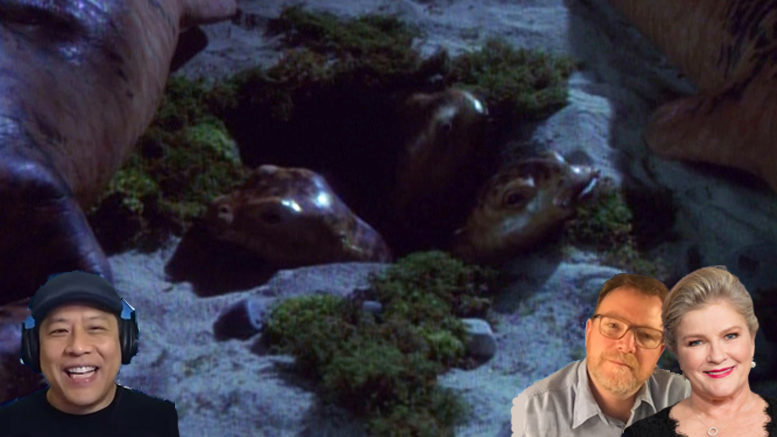
| November 25, 2020 | By: Laurie Ulster 33 comments so far
Ask a fan to name one of the worst episodes in Star Trek history, and Voyager ’s “Threshold” is bound to come up almost immediately. This much-maligned second-season episode, later described by its writer Brannon Braga as “ a royal, steaming stinker ,” is famous for what happens after Tom Paris crosses the Warp 10 threshold: He transforms into a monstrous creature, then kidnaps Captain Janeway and takes her to a planet where they turn into salamanders and have babies before they’re rescued and restored. There was even an action figure from Playmates , complete with three lizard babies, described on the package as “mutant offspring.”
Garrett Wang and Robert Duncan McNeill finally got to “Threshold” in the latest episode of their weekly podcast The Delta Flyers , where they are making their way through the entire series in chronological order. Earlier this year McNeill told TrekMovie that while he was happy with his work on “Threshold,” it was the only episode he wasn’t looking forward to discussing, but Wang rightly pointed out that fans likely felt the opposite.
Kate Mulgrew joined the pair with some extra commentary in the Patreon-only section of the podcast to reminisce about filming her scenes and speculate on how salamanders might copulate. Here are some of the highlights of their lively discussion, including the audio from the non-Patreon part of Robbie and Garrett’s discussion.
The award-winning makeup had its challenges
Mulgrew asked (sincerely) if the episode had won “a lot of awards,” and while McNeill joked that it won the award for “maybe the worst episode of Star Trek: Voyager ever made,” it did, in fact, win an Emmy for Outstanding Makeup for a Series—and the episode deserved it.
From McNeill’s description of filming his scenes as Tom Paris mutated, it sounds like he should’ve shared in that award along with Michael Westmore and his team. None of it was easy, starting with the menthol that was blown into his eyes to irritate them so they’d be bloodshot.
McNeill reported that when he filmed the scenes where he was losing his ability to breathe in Voyager’s atmosphere, it triggered his sense memories of having asthma attacks. He imitated them as a way to get into the scene, but his body picked up on what he was doing and he started to have the anxiety and tightness in his chest that always accompanied his attacks, so severely that rewatching it brought back all those feelings vividly. (In fact, he had once had an attack so severe during a different episode that they had to delay filming so he could go to the hospital.)
He also said it was difficult to act once the makeup reached its peak.
They had tubes that went down my legs, and they were sitting on the floor, like three feet away from me, literally they were going (blows), blowing these bladder balloons. So all I could hear inside of the rubber, I could barely hear the actors, I looked at their lips moving.
As for the horror movie-type scene where Paris’ tongue fell off:
That tongue was made of silicone. But then they put some other jelly, red, like Jell-O, so that it looked like it was sort of just collapsing or falling apart. So I did have some red Jell-O, and I had that silicone tongue, rubber tongue, had to get in my mouth… it was a lot of stuff for that tongue coming out.
And then for the final touch, he used an inky black mouthwash right before they filmed, so the inside of his mouth would appear black—and his real tongue would be harder to see.
Not just character mutation, but character evolution
Despite the episode’s bad reputation, Robbie and Garrett had some positive opinions on it. Wang thoughtfully pointed out that there was more to the changes in Paris than what was seen on the outside as they discussed how Tom changed over the course of the series. McNeill said he “came into the series embodying a lot of toxic masculinity” and Wang said this was embodied in the scene where Paris monologues from his sickbay bed. “You see the vestiges of the toxic masculinity even in this scene,” he said, bringing up Paris’ memories of crying alone as a kid and being told crying was a weakness by his father. ‘This is definitely a transitional phase for Paris to become more of a complete human being,” Wang summed up.
McNeill agreed, and admitted he relished the opportunity to stretch his acting chops.
My memory of making the episode, because I got to play the Elephant Man in a way, I got to play this transformation, this larger-than-life operatic story of the entire character changing, and dying, and coming back to life, and seeing things, having this acid-trip kind of revelations, my memory was, it was a lot of fun to act in. SO it was really satisfying for me as an actor.
Kate Mulgrew talks salamander copulation
Kate Mulgrew made her Delta Flyers debut (on Patreon only) and started off joking over their choice of episodes to discuss.
I was thinking about this last night as I put my little head on the pillow. Of ALL the episodes you could ask me to join you in conversation about, of everything we did together, every conceivable adventure, confrontation, peril, right? You choose “Threshold.” The story of Lt. Paris and Captain Janeway having lizards.
After their enthusiastic YES, she went on.
I didn’t think it was our finest moment, Robbie, but since we’re going to be talking about it, let’s extoll its virtues, okay? Locked in a turbolift with Robbie McNeill is something akin to delightful alcoholism, I should think. Because no aspect of it was based in reality of any kind.
She says she had fun–not always the case for her, given the grueling schedule–and confessed that her makeup had to be reapplied many times because McNeill kept making her laugh, reporting that it was his entire modus operandi as she was “..trying desperately to give birth to 25 lizards.”
While they made fun of the episode, they all acknowledged their admiration and respect for writer Brannon Braga and director Alexander Singer. Mulgrew’s theory is that the team had had so much pressure on them for the first season and a half that they needed a break of sorts, and that’s what they were trying to do with “Threshold,” but “…in so doing everybody lost their mind.”
Mulgrew asked where Harry was during all of this, since Ensign Kim wasn’t, as McNeill thought he should be, “sobbing inconsolably” in Sickbay as Paris suffered and died; she told Wang he must have been “off on your shuttlecraft, looking for the lizards that had escaped.”
Amidst all their laughter, McNeill said that he thought there was a “grain of a really interesting science fiction idea” in there, about becoming one with the universe simultaneously, describing it as “ kind of like an acid trip, in a way, I would imagine.”
“I think if we’re going to be very frank, I would’ve preferred an acid trip,” Kate replied, cracking up her co-stars. “That’s very lofty thinking.”
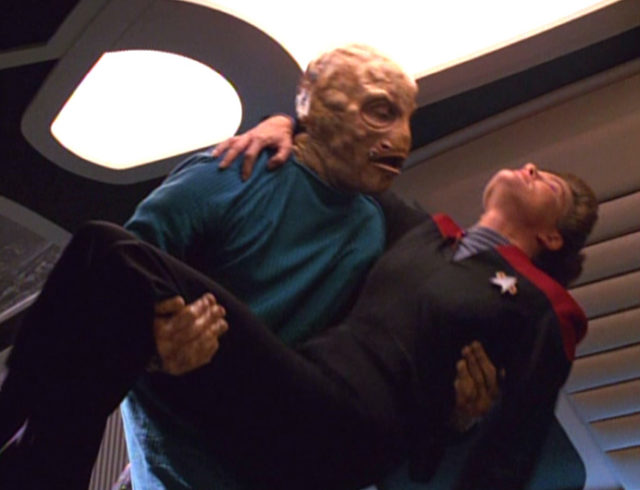
Who says romance is dead?
Wang pointed out “Threshold” was significant for being the only episode where Captain Janeway has sex, albeit as a salamander.
This is the first time and probably the only time that she has that. And also later, when you guys are back to human form… you’re both in Sickbay, and he looks at you very sheepishly, and he’s like, “Um, yeah, I’m sorry.” ‘Cause he still has knowledge that he had the intercourse with you. And then you, Kate, you look back at Robbie, you say, “Well you know, it’s all right, Mister Paris, but you do know that in a lot of different species, it’s the female that initiates the intercourse.” … It was almost, to me, a flirtation.
“That’s exactly right,” said Mulgrew. “Janeway did have a sense of humor, Garrett. And she often expressed it with Lieutenant Paris.”
“But,” she added, “ it does beg the question: I know that scientists will answer this… has anybody actually seen salamanders copulating? Have you guys ever actually witnessed it?”
McNeill chimed in, amidst their laughter, with “I will admit I did not do that research, Kate.”
Mulgrew doubled up.
I don’t think they copulate in any kind of way that could be confused with sexual intercourse. I don’t think there’s a great deal of, shall we say, foreplay.
“Tenderness, no,” posited McNeill, as Mulgrew ran with it:
Romantic pep talk? Erotic suggestions? I think they just slither on, and slither off.
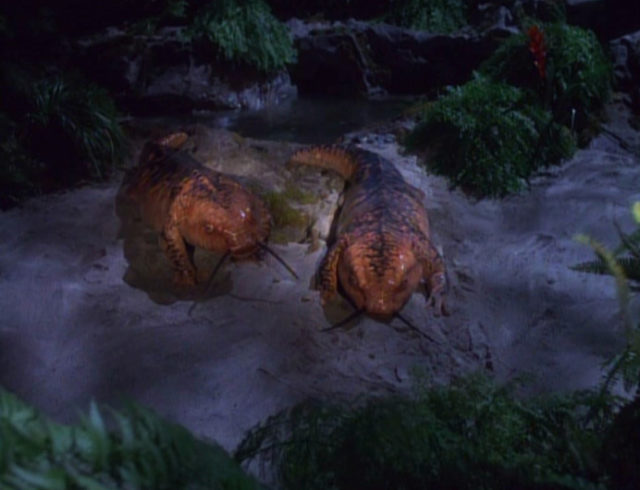
Janeway and Paris, slithering
Listen to The Delta Flyers on “Threshold”
For more exclusive interviews plus an extended version of the podcast and more, become a Patreon subscriber .
Keep up with the Star Trek celebrity news at TrekMovie.com .
Related Articles
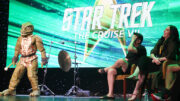
Conventions/Events/Attractions , Discovery
‘Discovery’ Panel Hints “Something Special” In Season 5, Gorn Gong Show, And More Star Trek Cruise Day 7

Conventions/Events/Attractions , Star Trek Universe TV , Star Trek: Legacy , Star Trek: Picard , TNG , Trek on TV , Upcoming TV projects
‘Picard’ Cast Talks “Cozy” Enterprise-D, Gates Hosts “Genesis” Watch Party, And More Star Trek Cruise Day 6

Conventions/Events/Attractions
Orchestral “Darmok,” Celebrity D&D, Ken Mitchell Memorial Rave, And More Star Trek Cruise Day 5
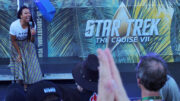
Star Trek Cruise Log: Day 1 Kicks Off With A Party On The Pool Deck And A Dancing Gorn
TOS : Spocks Brain TNG : Shades of Gray DS9 : Fascination VOY : Threshold DSC : * no comment *
ENT: “A Night in Sickbay”
But “Threshold” really isn’t the worst episode of Voyager by far, I’d but quite a few others in its place.
Oh i forgot ENT definitely Storm Front 1 and 2 !
I’d have to say “Once Upon a Time” is the worst.
Agreed on DSC. DSC has been very good so far.
For Enterprise, the Klingon Retrovirus eps were just horrible — the fan service was so obvious and forced.
TNG — Encounter at Farpoint and Unification — not that they were the worst, but given they were hyped so much, they were just such a disappointing letdown that it bothers me to this day.
TOS: Spocks Brain – yeah, that’s really a no brainer! :-D
TNG: why does everyone have issues with Shades of Gray? I loved all the flashbacks when I first saw it. Sure, it’s not the most creative kind of money-saving show, but I didn’t realize it at the time, and so I still like it. I’d probably pick Code Of Honor instead, though even that isn’t totally bad. In fact I’m rewatching season 1 right now, and I don’t find it nearly as bad as I thought it was…
DS9: haven’t watched alle episodes yet, so I don’t know about Fascination right now, but probably something from the first two seasons. Or anything with Sisko without the beard and with hair ;-)
VOY: agreed, there are a lot of episodes that are worse than Threshold. Sure, the salamander stuff is goofy, but the warp 10 concept was interesting, and overall it was done very well, I would say.
ENT: hmm, yeah, probably A Night in Sickbay, though that’s a nice Phlox story. Storm Front was hilarious, though, so probably that.
DSC: almost every episode, sorry.
I’d imagine Shades of Grey works better on the first run through the series but afterthat its utterly pointless and totally skipable. The thing is, a bottle show could have been done in far more original ways without any need for any SFX. Something maybe like a courtroom drama episode or a an episode where Picard sits in his quarters and talks about his life for 40 minutes to Wesley or something lol…
TOS: Spock’s Brain TNG: Code of Honor DS9: Move Along Home VOY: Threshold ENT: A Night in Sickbay DSC: *jury still out*
There, fixed your list “Tim”
Trek Worst List…
TOS: And the Children Shall Lead TNG: Sub Rosa DS9: Profit and Lace VOY: Threshold ENT: Unexpected DSC: Si Vis Pacem, Para Bellum PIC: The End is the Beginning LDS: Moist Vessel
Agree with And the Children Shall Lead. Spocks Brain is stupid, but it’s kind of silly good.
But Threshold is the worst
For me, the worst Voyager episode was Tsunkatse. The network was using the show as a blatant promo for The Rock.
So, Warp 9.99 is still the speed limit in the 32nd century, or are anti-mutation shields standard issue?
It looks like they use quantum slipstream technology now.
For me personally, the episode would have been do much better off what they were apparently trying to discuss, really occured. I mean for all these astonishing situations (crossing warp 10, unifying with Universe, dying, resurrection, turning info something completely different) informed character growth. I’m often saying that Star Trek isn’t a soap opera, it shouldn’t rely so hard on characters backstory, romances (like Discovery did on the first season or two), because no matter how good the characters are they shouldn’t be overshadowing what the franchise is (should) be about – you know – STAR TREK. By the way – DS9 is for me not an exception, because I consider it to be a great seria, my beloved one amongst those under ST name, but still – not a good Star Trek. With all that said – if you are having an episode od sci-fi where a single character goes through all those great SF situations, you need some context for them to work to make viewers think about how that could be transitioned to human condition. Threshold doesn’t give you enough of this on this almost Kafka’esque story and this is, in my opinion, why it gets what it deserves on the discussion boards.
This episode was awkward but I liked it.
If Tom Paris’ insubordinations are so-called “male toxicity”, maybe someone can enlighten me what to call Michael Burnham’s far more consequential insubordinations (not to forget her stereotypical inability to keep her emotions in-check, as behooves a professional officer and scientist)? At least Tom Paris didn’t start a mutiny that resulted in an interstellar war…
Um… not his insubordinations. More his constant hitting on women, which started in the very first episode. I recommend you listen to the Delta Flyers podcast, Garrett and Robbie have a great conversation about it.
Other than Thirty Days when was Paris insubordinate? That whole Season 2 arc was all a subterfuge, he wasn’t really being insubordinate.
I love Voyager and her crew to death but Threshold makes Spock’s Brain look like an Emmy winning episode. It’s just SO bad! I’ve only seen it twice to this day.
But these guys, Mulgrew especially, seem to have a good laugh about it. It’s nice they can just reminisce about the more awful stuff and not sound bitter about it.
Well, I’ve never got that hatred for “Threshold”. It was a mediocre, paint-by-numbers episode, forgettable and bland, but it’s not nearly as bad as some people want into to be. The worst episode was “Course: Oblivion”. I simply couldn’t stand the bleak, depressive resolution.
As for TOS: “Spock’s Brain” is campy fun but also by far not the worst of them. I really disliked “The Omega Glory” and “Plato’s Stepchildren”, though that kiss made TV history. But actually I liked “And the Children Shall Lead”. It has a certain “Children of the Corn” feeling, decades before those movies were made.
TNG… I don’t know. “Shades of Grey” was a filler with flashbacks that came for too early to be effective. I would have loved to see this in Year 7 with all of the series being covered. But again, it wasn’t bad at all. There are hardly any superbad TNG episodes. I like “Sub Rosa”. It’s not great but not bad either. I wasn’t a big fan of “Lessons”, but it wasn’t a stinker, just not particularly interesting.
ENT… Sickbay is okay with me. The worst disappointment was “These Are the Voyages” but only because they made it the series finale. As a standalone entry, it would have been quite neat.
DSC… Not a big fan of the rushed S1 finale but again, not a total loss. I have no DSC episode I totally dislike though I take issues with some scenes, especially the excessively bloody ones.
PIC… That’s why I hate “Stardust City Rag” for it’s Icheb opener.
Wow. I think Course: Oblivion is excellent. Especially on first watch, when we didn’t know what was going on. Parallel universe? Bad dream? I never saw the link to Demon coming.
Am I the only one who actually really liked this episode? I remember I watched it several times.
Very possibly, yes. I’ve never seen a “worst episode ever” list where Threshold was not near the top.
I loved A Night in Sickbay on ENT, thought it was a fun episode!
It was okay. I never understood the hate for it, either. It is just kinda there, neither good nor bad IMHO.
It’s not completely true that this is the only episode where Janeway has sex. In Fair Haven she most likely has sex with one of the holodeck characters, Sullivan. Chakotay even admits to having sex on the holodeck himself! And now that I’m thinking about this there’s another epispode… Janeway and some of the crew are abducted and brainwashed in two parter Workforce. Janeway meets a co-worker, Jaffen (love that name!), and decides to move in with him. I mean, c’mon! Either way, she has her fun more than once on the show. While sexuality is not required to make a show good, I think it’s good for her character and the show.
Definitely in Workforce! But that hadn’t happened yet, so I guess this is the FIRST time on the show? (I love Workforce.)
As it happens, Salamander “foreplay”, which in this case means things the male does to get the female ready to mate, is much longer than typical human foreplay. But it’s instinctive in nature, we can’t really say it’s “fun” for them.
The dumbest part is that because the condition was reversible, they could have adapted the ship, went home, and reversed it.
Don’t know why Voyager got a bad rep in Trek social circles. Was the best out the lot of them. I even thought there would be a spin off series when she meets the Federation Timeship of the future. Not just boldly going in space but also in time. I would’ve watched that. Big up all the cast and Crew of the USS Voyager.. Cmon guys. Enuf reminiscing. As old as they are now, I’d still watch new episodes any day. 😉
For me, the worst episode of Voyager is “The Fight”. It was the only episode that was such a struggle to get through. Interesting idea, but the execution was just awful. I felt embarrassed for the actors, especially Chakotay
I think I agree with you! I hated “The Fight” and “False Profits.” Those were the weakest ones in my book. “Threshold” is still entertaining, and Robert Duncan McNeill did a great job with it.
Create a free profile to get unlimited access to exclusive videos, sweepstakes, and more!
WTF Moments: The craziest thing Star Trek: Voyager ever did involved lizard sex
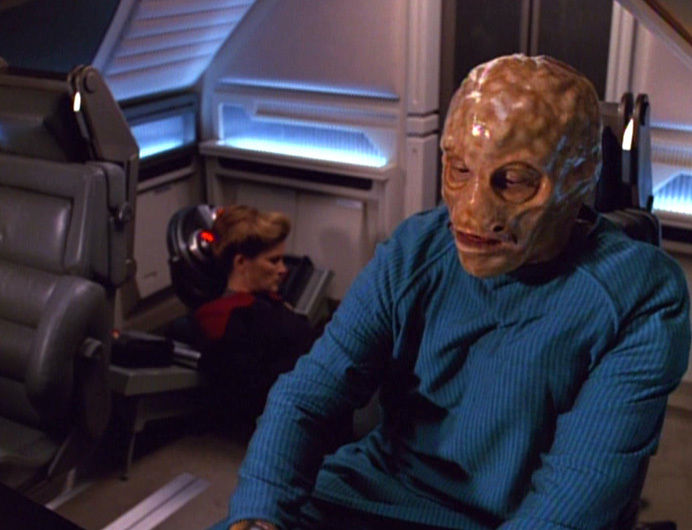
Credit: CBS
In hindsight, we can say that Star Trek: Voyager absolutely got away with some crazy s**t.
Think "splicing Vulcan Tuvox and Talaxian Neelix into Tuvix" crazy. Or a scene in the pilot, which aired 25 years ago this week, where cocky helmsman Tom Paris — trapped in a cave — asks his Native American colleague "Isn't there some Indian trick, where you can turn yourself into a bird?" They even had an empathic serial killer aboard.
But the craziest thing to air on Voyager — and from Star Trek in general — has to be Season 2's "Threshold." The one where Paris breaks the impossible Warp 10 speed barrier, devolves into a lizard, has sex, and makes babies with Captain Janeway… who is also a slug lizard.
Yup. You can practically smell the crazy on this one.
What the ship's doctor, an Emergency Medical Hologram (EMH), calls a "future stage in human development" looks like rejected concept art from the original V miniseries, as Paris escapes from Voyager's sickbay and hunts down Captain Janeway . Outside a turbo-lift, Paris gets the drop on Janeway and abducts her. Why? So he can smuggle her aboard a special shuttle refitted to go Warp 10, turn her into a lizard thing, too (off-screen), and then mate and procreate with her and have tiny lizard babies.
(I mean, who among us has not set out to break the laws of physics so we could impregnate a superior officer with our space iguana spawn?)
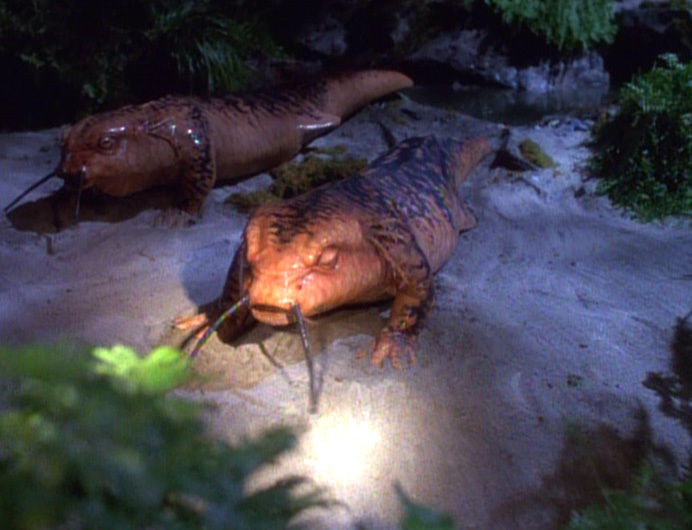
Eventually, members of the Voyager crew find Paris' shuttle on a jungle planet. They soon discover he, their captain, and their offspring in the form of palm-sized lizards. Back on the ship, the EMH is able to eradicate this mutation from both Paris and Janeway's genome (because science!) and restore them to their human forms.
Janeway confronts Paris for what he submitted her to. She had never had children before, and now the ones she did have — she was forced to leave them behind on a planet 75 light years from Earth. From there, an ashamed Paris resigns his commission and waits for Janeway to forgive him and — nope! Sadly, none of this happened... minus the leaving the kids behind bit.
Instead, "Threshold" ends on the emotionally dishonest note of Janeway and Paris having the briefest conversations about their de-evolution. With a smirk, Janeway remarks, "I thought about having children, but I never considered having them with you." And then, as a joke, Braga has Janeway flippantly dismiss what happened to her, without her consent, with the line "sometimes it is the female of the species who initiates mating." *forehead, desk*
"It's a terrible episode," Braga says on the 2003 DVD set for Season 2, nine years removed from the making of what fans consider to be among the worst hours of Trek ever produced.
24 years after it aired, he and the fans are not wrong.
- Star Trek: Voyager
- WTF Moments
Related Stories

Flushed Away Director On Aardman's First CG-Animated Feature

Anthony Mackie On John Doe Vs. Sam Wilson

Bruce Almighty Teleprompter Scene Wasn't in Original Script

The Fast and the Furious: Remembering how the Fast Saga began

The Definitive Guide to The Munsters Adaptations

Remembering Evolution, David Duchovny's Wild 2001 Sci-fi Film

The Hunger Games Timeline, Briefly Explained

Winnie-The-Pooh: Blood and Honey Creators Tease Shared Universe

All of The Leprechaun Movies, Ranked

Eternal Sunshine Director Made Wild Request of Jim Carrey Ahead Of the Film's Shoot

Back to the Future Easter Eggs You Almost Certainly Never Saw Revealed

John Carpenter's The Thing: Definitive Oral History
Recommended for you.

Linda Hamilton on Resident Alien Role: "I'm Not the Funny Girl, I'm the Straight Man"

The Classic Twilight Zone Episode That Inspired Jordan Peele's Us

Resident Alien's Alan Tudyk on Harry's New Love Interest, Edi Patterson's Blue Avian
The News Of Tomorrow, Today
Subscribe to our newsletter!
Now you can get the top stories from Gizmodo delivered to your inbox. Enter your email below.
By subscribing you agree to our Terms of Use and Privacy Policy.
By subscribing you agree to our Terms of Use and Privacy Policy.
Happy 25th Anniversary to Star Trek: Voyager’s Infamous Lizard Sex Episode, ‘Threshold’

“Threshold” is considered one of, if not the , worst episodes of Voyager and it’s honestly a little hard to refute. Things start well enough in a traditional S tar Trek -ian manner: Tom Paris takes an experimental voyage in an attempt to become the first being to ever cross the Warp 10 barrier. He briefly succeeds, discovering it essentially sends his consciousness to every point in the universe simultaneously for a tiny bit. When he recoalesces, he’s a little discombobulated, and then he starts mutating, and gets much more discombobulated.
(Just in case you didn’t watch the entire video above, I do need to inform the mutation causes Paris to vomit out his tongue, which is quite something!)
During a potential treatment to return him to human form, Paris breaks out, grabs Janeway, steals a ship, and escapes at Warp 10 again. A few days later, the Doctor (Robert Picardo) finally has a theory about what’s happening to the former flight officer, which is essential to understanding why this “Threshold” is so infamous: The Doctor believes that achieving Warp 10 hasn’t caused Paris to mutate, but evolve at an astonishing rate — he might be reaching an evolutionary apex that the rest of humanity won’t achieve for millions of years. It’s weird to think humans would eventually grow out of a need for tongue, but evolution can be wacky that way. Still, when the stolen craft is found on a remote planet, evolution has been far, far wackier than anticipated:
Yes, humanity’s future will be as amphibious, quadrupedal lizards. Not lizard men , lizards. With catfish whiskers. But there’s one thing evolution hasn’t changed: The desire to keep one’s species alive. So lizard-Janeway and lizard-Paris lizard-fucked, lizard-Janeway had lizard-babies, and the non-lizards on the Voyager crew grabbed their former fellow officers and abandoned those lizard-babies as quickly as humanly possible.
I’m an extremely casual Trek fan at best, but it does strike me that leaving creatures that are technically children of two Voyager crewmembers on a planet that they’re not from — and could be in danger of getting killed or destroying the native eco-system — jibes with the Prime Directive. It’s even weirder when you wonder that, since Janeway and Paris can be (and are) turned back into humans, those are three potentially human children being ditched on the side of the galactic road. Then there’s, you know, the whole fact two main characters on the show turned into lizards and had sex of extremely dubious consensuality.
But the craziest part to me is the show’s absolutely bananas theory that these things are humanity’s evolutionary future. It turns out that wasn’t originally the idea for the episode, though. Longtime Trek producer and screenwriter for the episode, Brannon Braga said in Captains’ Log Supplemental: The Unauthorised Guide to the New Trek Voyages (as recorded by Memory Alpha ):
It’s very much a classic Star Trek story, but in the rewrite process I took out the explanation, the idea behind the ending, that we evolve into these little lizards because maybe evolution is not always progressive. Maybe it’s a cycle where we revert to something more rudimentary. That whole conversation was taken out for various reasons, and that was a disaster because without it the episode doesn’t even have a point. I think it suffered greatly.
- Show Spoilers
- Night Vision
- Sticky Header
- Highlight Links

Follow TV Tropes
http://tvtropes.org/pmwiki/pmwiki.php/Recap/StarTrekVoyagerS2E15Threshold
Recap / Star Trek: Voyager S2E15 "Threshold"
Edit locked.

Here lies Thomas Eugene Paris. Beloved mutant.
This episode provides examples of
- Aliens Made Them Do It : Paris and Janeway are accidentally transformed into nonsapient animals, mate and produce a litter of offspring. Probably the most bizarre way of getting two main characters to make out in sci-fi history!
- Artistic License – Biology : The episode features a notoriously bad depiction of evolution . According to the script, not only can individual beings evolve into a completely different form, but the path of that evolution is laid out by fate.
- The Atoner : Tom thinks that being the first to breach the Warp 10 barrier will make up for his being a failure in life.
- Big "NO!" : Tom shouts one as he begins his transformation.
- Body Horror : Paris's mutation causes his DNA to break down, gradually making him look less human and more alien. At one point, he spits out his tongue , thus making talking difficult for him. Unsurprisingly, the episode won the Emmy for Best Makeup Effects.
- Contrived Coincidence : Warp 10, according to this episode, makes you somehow everywhere in the universe at once. So how convenient that Tom rematerializes right back near the ship! And on mutant!Tom's second attempt with Janeway, they just wind up on a nearby planet, makin' salamander babies.
- Cool Ship : The squat Type 6 shuttlecraft is replaced by the sleek Class 2, dubbed the 'Speedboat Shuttle' by the production staff and fans.
- Creator Provincialism : Janeway says Tom will be joining the likes of Orville Wright, Neil Armstrong, and Zephram Cochrane. Many viewers noted the oddity of her not mentioning the actual first man in space, Yuri Gagarin. Not to mention that all of these are Humans.
- Danger Room Cold Open : The episode opens with Tom in a shuttlecraft that breaks up as he hits the Threshold. We then cut to Tom sitting on the floor of the holodeck . B'Elanna: You're dead.
- Death Is Cheap : Tom dies, his cells so damaged the Doctor doesn't try to revive him past the first attempt . Then he comes back to life again. He and Janeway mutate into lower lifeforms and are brought back to perfect health.
- Easily Forgiven : Tom Paris because he was literally Not Himself at the time, what with being a catfish and all. As for the kids, Janeway jokes that it might have been her idea.
- Famous, Famous, Fictional : Janeway tells Tom that by being the first man to breach the Warp 10 barrier, he'll be joining the ranks of Orville Wright, Neil Armstrong, and Zefram Cochrane. This case differs from the usual trope in that Cochrane is from already established Trek canon (he invented the warp drive on Earth, and thus the Vulcans decided it was time for First Contact ), rather than a completely made-up name.
- Foreshadowing : Janeway says that the ability to fly at warp 10 will change the nature of humanity's existence. Yeah, turning into a catfish will do that...
- Forgotten Phlebotinum : Even ignoring the lizard-fication, it's mentioned that the experimental shuttle's computers were jam-packed with helpful navigation aids and maps — which are never mentioned again.
- Formerly Sapient Species : Tom Paris's "accelerated evolution" into a non-sapient salamander-like creature. The writer of this episode has stated that his idea was that in the distant future, humanity would evolve beyond the need for sapience due to technology providing for all our material needs.
- FTL Test Blunder : Paris figures out transwarp traveling, which might get the ship back to the Alpha Quadrant. After a seemingly successful test, he has an allergic reaction to water and starts de-evolving into a salamander/lizard/catfish creature. And then things get very weird.
- Golden Moment : At the end of the episode, Tom realises that doing something famous is not going to solve his issues.
- Gone Horribly Wrong : Just for starters, Tom, upon returning to the ship, becomes allergic to water. Somehow, it goes downhill from there.
- If I Do Not Return : Tom's last words before he (temporarily) dies. Tom: Do me a favor. When I'm gone, call Starfleet Headquarters and tell Dad that I did it. Tell him...
- I Just Want to Be Special : What drives Tom into this whole mess.
- Impossible Genius : Quite a few reviewers wondered why the crew didn't just transwarp back to the Alpha Quadrant regardless , given the Doctor's miraculous ability to restore them from an amphibious state. Though given the stress the transwarp flight put on the shuttle, it's possible Voyager wouldn't have survived.
- The Infinite : Tom Paris designs and builds an engine to go To Infinity And Beyond!! As a drive the infinite turns out to be improbable though.
- Just Think of the Potential! : Why, they could get home instantaneously, change space travel forever, but most of all, let Tom work out his daddy issues!
- Last Kiss : Tom asks for a last kiss from Kes, but she points out that he'll die if they let down the medical forcefield. After Tom dies anyway, a distraught Kes kisses him on the cheek.
- Subverted when we find the reason Tom found Neelix's special blend so disgusting is that he's allergic to the water due to the changes in his body.
- Ludicrous Speed : Doesn't even begin to describe it.
- Men Don't Cry : According to Admiral Paris, apparently. Tom doesn't buy it.
- Mistaken for Gay Tom: Kiss me! Doctor: What?! Tom: (indicating Kes) Not you! Her!
- The Mole : Judas...err Jonas transmits details of the Warp 10 experiments to the Kazon. Unfortunately they didn't turn themselves into catfish trying it out.
- Tom is shouting "I'm breaking up!" accompanied by Explosive Instrumentation , then we Smash Cut to B'Elanna and Harry looking bored on the holodeck, with Tom sitting on the floor.
- Tom himself is this In-Universe ; he goes from afraid to angry, to meek and pleading then back to belligerent again, sometimes mid-sentence.
- Mundane Solution : After the Doctor confirms Tom is only unconscious, Janeway says to wake him up. Instead of the expected hypospray of stimulant, Doc leans down to his ear and shouts, "Wake up, Lieutenant!"
- Not Himself : Mutant!Tom lashes out verbally at Captain Janeway, accusing her of wanting him dead as he's an embarrassing failure.
- Ominous Hair Loss : Right after coming back from the dead, Tom finds himself losing clumps of hair, the prelude to the next stage of his mutation.
- Our Dark Matter Is Mysterious : One of Neelix's anecdotes about losing a nacelle passing through a dark matter nebula gives Tom and Harry inspiration to finish their transwarp drive.
- Screw This, I'm Outta Here : Chakotay, having retrieved Janeway and Paris, apparently decides this about the lizard babies.
- Ship Tease : This episode marks the first time its hinted that B'Elanna may be starting to consider Tom more than a crewmate.
- Passing through all points of the universe simultaneously, causing ridiculous things to happen, sounds a lot like the Infinite Improbability Drive . Well, it did turn Ford into a penguin... but he got better.
- Tom comes back to life with a changed face and two hearts .
- Snark-to-Snark Combat Paris: You're losing me, aren't you? I'm going to die. Doctor: You're too stubborn to die, Mr Paris. Paris: Here lies Thomas Eugene Paris. Beloved mutant. Doctor: A fitting epitaph, but I don't intend to let you use it just yet.
- Snowy Screen of Death : Mutant!Tom's escape is only shown by Doc and Kes watching it on the viewscreen . Phaser beams can be seen cutting across Engineering until one knocks out the screen.
- Swiss-Cheese Security : Tom is able to break out of his chamber, take out the security officers guarding him, screw up the internal sensors, abduct Captain Janeway and steal the Warp 10 modified shuttle without any problems. And all this after Tuvok promised Janeway there wouldn't be any more shuttle-stealing incidents in " Maneuvers ".
- Tainted Veins : When Tom first collapses in the canteen.
- Take Our Word for It : The mutated Tom breaks out of his restraints and starts a huge fight with the security team. None of this event makes it on-screen. Instead we have Torres telling the Doctor what is happening.
- Techno Babble : When Tom and Harry have their "Eureka!" Moment . Neelix: I have no idea what they just said.
- That Didn't Happen : Chakotay wonders how the hell he's going to explain in the log that a Starfleet officer abducted the captain, evolved into a lower lifeform and had babies with her. Captain Janeway however takes the matter in stride, suggesting the sex might have been her idea.
- Timey-Wimey Ball : Implied with Tom's incoherent explanations. "The present, the past, they're both in the future. The future is in the past."
- Title Drop : "I'm approaching the Threshold!"
- Too Much Information : Tom discusses how he lost his virginity at 17 while his parents were out of the house. Doctor: I'll...note that in your medical log.
- Too Strange to Show : What Past-Warp-10 looks like. We only see Tom's face when he does it the first time, and the second time, we only see the multi-colored streaks of hundreds and thousands of stars streaking by at super-warp, before the screen fades entirely to white.
- Touch of the Monster : Mutant!Tom carrying Janeway in his arms as he places her in the shuttle.
- Unable to Cry : Tom says that B'Elanna won't be crying at his funeral as she never cries.
- Weaksauce Weakness : Super-evolved catfish things get put down pretty quickly by basic phaser fire.
- "Well Done, Son" Guy : Tom's last words before he dies are to let his father know he crossed the Threshold.
- What Happened to the Mouse? : We see the mutant children of Tom and Janeway enter the slimy pool and...they're never mentioned again.
- Whole-Plot Reference : Brannon Braga wrote the episode as a homage to David Cronenberg 's The Fly .
- You Cannot Grasp the True Form : Tom finds it difficult to explain what traveling through every point in the universe is like.
- You Talk Too Much! : Not imminent death, mutation, or even the loss of a tongue stops Tom from rambling away. Tom: Doctor, I need to talk! Doctor: So I've noticed.
Chakotay: I... don't know how I'm going to enter this into the log. Tuvok: I look forward to reading it.
- Star Trek Voyager S 2 E 14 "Alliances"
- Recap/Star Trek: Voyager
- Star Trek Voyager S 2 E 16 "Meld"
Important Links
- Action Adventure
- Commercials
- Crime & Punishment
- Professional Wrestling
- Speculative Fiction
- Sports Story
- Animation (Western)
- Music And Sound Effects
- Print Media
- Sequential Art
- Tabletop Games
- Applied Phlebotinum
- Characterization
- Characters As Device
- Narrative Devices
- British Telly
- The Contributors
- Creator Speak
- Derivative Works
- Laws And Formulas
- Show Business
- Split Personality
- Truth And Lies
- Truth In Television
- Fate And Prophecy
- Edit Reasons
- Isolated Pages
- Images List
- Recent Videos
- Crowner Activity
- Un-typed Pages
- Recent Page Type Changes
- Trope Entry
- Character Sheet
- Playing With
- Creating New Redirects
- Cross Wicking
- Tips for Editing
- Text Formatting Rules
- Handling Spoilers
- Administrivia
- Trope Repair Shop
- Image Pickin'
Advertisement:
How One Of Star Trek: Voyager's Weirdest Concepts Wound Up In Lower Decks
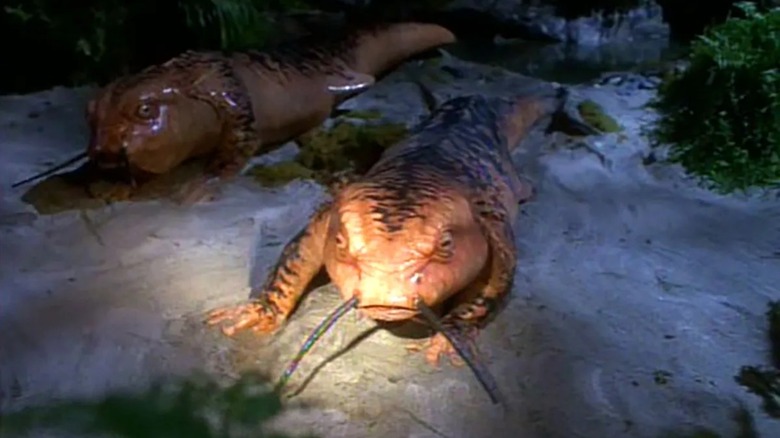
In the first episode of the fourth season of "Star Trek: Lower Decks," called "Twovix," the crew of the U.S.S. Cerritos has been given a delicate mission. It seems that the U.S.S. Voyager, having returned from the Delta Quadrant only a few years prior, has now been converted into a flying museum commemorating that ship's many adventures. The Voyager must be accompanied to Earth, where it will be opened to the public, and the Cerritos has to oversee the transport. The old Intrepid-class starship contains mannequins wearing mission-worn uniforms and touts periodic diorama-bound exhibits explaining some of the Voyager's more outlandish shenanigans. "It's Voyager," one of the Cerritos crew members fliply points out, "S*** got crazy."
One of the stranger exhibits features a pair of outsize, orange animatronic salamanders that will be instantly recognizable to "Star Trek: Voyager" fans. In the episode "Threshold" (January 29, 1996), the Voyager crew discovers a way to break the Warp 10 barrier and achieve infinite velocity. This would allow them to pass through every point in the universe simultaneously, and would certainly help the lost ship return home to Earth. However, when Tom Paris (Robert Duncan McNeill) tests the technology on a modified shuttlecraft, he returns changed. His body begins mutating like in David Cronenberg's "The Fly." It seems that breaking the Warp 10 barrier caused Tom to hyper-evolve.
After he has partially transformed into an amphibian, Tom kidnaps Captain Janeway (Kate Mulgrew) and also takes her on a Warp 10 flight. The pair are later discovered on a nearby planet, having fully transformed into four-foot salamanders ... and having mated.
The director of "Twovix," Barry Kelly, recently discussed the references to "Threshold" with MovieWeb . He noted that turning the old episode's odd story into a new in-universe animatronic was a challenge.
The challenges of an animatronic salamander
Kelly felt that Tom Paris and Captain Janeway did not evolve into salamanders in "Threshold" but into reptiles. Regardless, it's a strange story and one that is made all the stranger by the fact that Tom and the Captain mated while in their animal form. When the two officers are rescued by their fellow Voyager crewmates and transformed back into humans, Janeway notes that she sometimes envisioned having children ... though not quite under those circumstances.
"Threshold" was weird enough that Kelly required references to it for "Twovix." He said:
"There were some challenges in ['Twovix']. In 'Star Trek: Voyager,' there was an episode where Tom Paris and Capt. Janeway hyper-evolve into lizards and it's just such a weird concept. And we couldn't have a 'Voyager' episode without it. So, we wanted to make something like a museum exhibit that has these lizards as animatronics on display. But we wanted it to look like a specific animatronic you see at Disney or something."
This, of course, is a sci-fi anachronism. In a future full of elaborate hologram technology and life-like intelligent machine species, is a quaint, Disneyland-style animatronic really going be to built? Probably not, but it provides for a cute gag and an amusing reference. The future anachronism can be forgiven. Kelly noted that the salamanders had to look artificial, so he made them look clunky, low-tech, and a little, in his words, "dumb":
"We had to give it joints and make it kind of walk dumb. We tried to make it like a dumb robot, and then it gets hacked. So, we have this threat, [then] these holograms that are classic, and then 'Voyager' episode characters come in."
Clarity is key
Of course, clarity was key for Kelly. Unlike in an explanatory article on /Film, he didn't have the space or the time to explain the references or where the salamanders came from. The gag plays better if a viewer is familiar with "Star Trek: Voyager," but Kelly was more concerned with viewers who weren't. As such, when an obscure returning character appears on "Lower Decks," he needed to include quick visual shorthand for who they were and if they posed a threat or not. The "Voyager" references were particularly hard to deal with as "Voyager" was a wild show, complete with 1930s-style holographic villains, sexy Irish boyfriends from the 19th century, and hyper-evolved salamanders. Kelly said:
"For us, it's always about nailing those weird concepts and making sure that when the audience is watching it, they understand what they're looking at. That was one of the challenges, but it was a fun one. I can't always say, like, I need to make an evil robot lizard in every TV show I work on."
One might hope that some of the oddball ideas in "Twovix" might translate to younger viewers wanting to go back and watch "Voyager." Of the extant "Star Trek" shows, "Voyager" had some of the stranger and more ambitious stories. It wasn't always a great show — "Threshold" is often cited as one of the more outlandish episodes of the series — but one can admire its ambition and temerity. When it comes to "Voyager" references on "Lower Decks," the show's writers all must face a similar challenge to Kelly's. Namely: How do we make these weird-ass stories feel natural in the world of "Star Trek?"
- Buy the Book…
- Reviews Hub

the m0vie blog

Following Us
- Adding Our RSS Feed to Your Gmail
- Following our Feed in Internet Explorer
- Millennium (Reviews)
- Star Trek: Deep Space Nine (Reviews)
- Star Trek: Enterprise (Reviews)
- Star Trek: The Next Generation (Reviews)
- Star Trek: The Original Series (Reviews)
- Star Trek: Voyager (Reviews)
- The X-Files (Reviews)
- X-Files Fandom Poll Form
Check out the Archives

Awards & Nominations

Star Trek: Voyager – Threshold (Review)
This February and March, we’re taking a look at the 1995 to 1996 season of Star Trek , including Star Trek: Deep Space Nine and Star Trek: Voyager . Check back daily Tuesday through Friday for the latest review.
Threshold is hated by fandom.
Veteran reviewer Jamahl Epsicokhan described it as “one of the all-time worst episodes of Star Trek ever filmed.” He is far from the only voice raised in protest. Winston O’Boogie remarked that, watching the episode, “you can’t help but think that something has gone terribly, terribly wrong with the world that allowed this to happen.” Assessing writer Brannon Braga’s contributions to the larger franchise, Jim Wright reflected, “Whatever else he may accomplish, he’s as forever shackled to Threshold as George Lucas to Jar-Jar.”

It’s not even the worst episode of the season…
Threshold is terrible. There is no way around that. It is a very stupid episode that is never entirely sure what it is trying to say from one moment to the next. More than that, positioning it as an important Tom Paris arc in the middle of the second season serves to sabotage the already confused character arc running between Alliances and Investigations . There is absolutely no context in which Threshold could be described as a “good” (or even “competent” ) hour of television.
At the same time, it is not one of the worst episodes of the franchise ever produced; it is not even one of the worst episodes of the series. Surrounded by episodes like Tattoo or Alliances , the episode cannot even make a particularly confident claim to being the worst instalment of the season. None of this should be confused as an endorsement of Threshold . It is condemnation of everything that exists around Threshold .
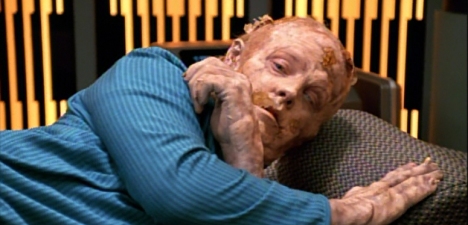
The great mutato!
It’s interesting to wonder why Threshold generated such a strong response from fandom. The episode is terrible, but there were so many terrible episodes airing around it that it seems weird to focus hatred on this individual story. After all, Threshold aired directly following Alliances ; that particular episode found Janeway opting to ally with white-skinned slave owners instead of their dark-skinned former slaves, offering a big sanctimonious speech at the end about how, if she can’t trust slaveowners, then Voyager must truly be on its own.
This is to say nothing of the script for Tattoo , an episode about a bunch of magical white-skinned aliens who came down from the heavens and gave indigenous populations a spark of divine genius that somehow makes them all mystical or something. There is a lot of unfortunate racial subtext running through the second season of Star Trek: Voyager , and that is without considering the implications of the whole “Kazon as Los Angeles street gangs” theme that Michael Piller and Kenneth Biller thought would be fun to thread through the season.

“Computer, play some ambient thunder noises in the background…”
In light of all this, it seems a minor miracle that Threshold decides to mangle evolutionary theory in a manner that is simply idiotic rather than explicitly racist. Considering the handling of race in scripts like Tattoo and Alliances , it is a wonder that Tom Paris evolves into a space! salamander rather than a space! W.A.S.P. Threshold is terrible and ill-conceived on multiple levels, but at least it is not spectacularly racist. That should be a fairly low bar for any episode Star Trek to pass, but it seems to be a lot tougher than it should be this season.
(This is not to suggest that Threshold doesn’t have its own rather problematic moments. After all, mutant! Paris abducts Janeway for the purpose of making mutant! babies with her. The closing scene tries to shrug that off, with Janeway remarking that “sometimes it’s the female of the species that initiates mating.” However, the point of the abduction is clear, even if mutant! Janeway consented to freaky mutant! sex. Given the second season’s fixation on female characters as mothers, the whole climax of the episode is ill-conceived. At best.)

The episode really blew up in everybody’s faces…
What is it about Threshold that provokes such a strong and emotive response from fandom, while other second season episodes simply get a pithy dismissal or a half-hearted critique? Perhaps a lot of it is down to the positioning of Threshold . This is not a good episode, and it comes at the end of the first half of a season that has struggled to produce a handful of passable hours of television. More to the point, Voyager has yet to produce a truly classic or defining episode; the first season has come and gone without a hint of a Duet or a In the Hands of the Prophets .
There are good episodes in the first stretch of the second season; Projections is genuinely great, while Persistence of Vision and Resistance are generally entertaining. Nevertheless, it has been a long and painful slog through the second season. There is a lot of crap here. It isn’t even like the second season of Star Trek: Enterprise , where everything blends into a competently-produced blur with no distinct flavour; there are genuinely terrible episodes scattered through the season, with the production team messing up what should be simple Star Trek stories.
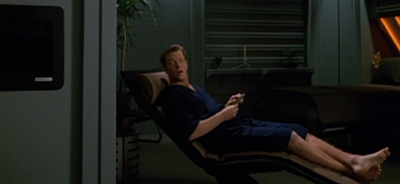
“So, yeah. Maybe Kim should do it.”
Perhaps the hatred is cumulative. Maybe Threshold is simply the straw that broke the camel’s back. The episode is certainly more engaging than Twisted ; it is certainly less actively racist than any episode featuring the Kazon. In some respects, Threshold arrives at a low point in the second season. The second season does have some legitimately great episodes coming up in a fairly short space of time, with one genuine masterpiece and a number of nice character-driven stories for the ensemble. There are still a few stinkers to come, but less than there were before.
That said, it feels like an unconvincing explanation for the raw anger that Threshold provokes from fans. It is interesting to wonder if the aggressive response to Threshold is rooted in the fact that it is a very silly episode of television. After all, Star Trek fans tend to take the show very seriously; Kenneth Biller was very eager to complain about the goofy and pulpy design of the robots in Prototype , ignoring that the retro design was perhaps the the strongest part of an episode with a number of very questionable storytelling choices.
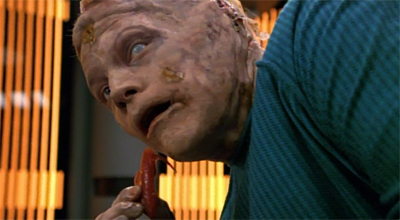
Mutant got your tongue?
The episode was originally pitched by Michael De Luca, the head of New Line Cinema who had struck up a friendship with Brannon Braga. De Luca explained his original pitch :
I think my pitch was if you break the warp ten barrier you…at warp eleven you’re in touch with every molecule in the universe at the same time and it has a bad effect on that character on the show that played the test pilot. I think it was Lieutenant Paris or something. So, they bought the story and I got to have my name on that episode of the Star Trek series and it made me really happy.
De Luca’s writing credits include Freddy’s Dead: The Final Nightmare and Judge Dredd , giving an indication of the sensibilities of his pitch. This is not the sort of science-fiction that nineties Star Trek did very often.
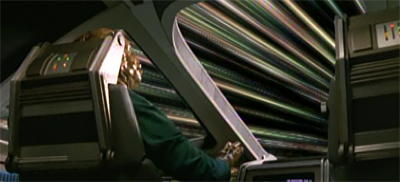
Threshold is a very pulpy episode of science-fiction. If the robots from Prototype look like they escaped from a fifties or sixties b-movie, it seems entirely possible that the script for Prototype is another refugee from late-night broadcasts of cheap horror films. Brannon Braga has always been fascinated by schlock and horror, with his work on Threshold sitting comfortably between his scripts for Genesis or Microcosm . Much of Threshold plays as an attempt to do trashy body horror within a familiar Star Trek framework.
Braga’s script is aware of its ridiculous elements. “Here lies Thomas Eugene Paris, beloved mutant,” Paris laments as the EMH and Kes fight to save his life. As the EMH prepares to infuse him with radiation, Paris amends his epitaph, “Great. Now it’ll read, beloved radioactive mutant.” After his supposed death, the EMH is working in Sickbay (with the lights turned down low for maximum horror vibe) only to discover that the pilot has been resurrected. Pulling back the tarp draped over the body, the EMH declares, “You’re alive.” Victor Frankenstein would be proud.

The monster demands a superior officer…
Discussing the episode, Braga has explained that he was attempting to do high concept body horror within the structure of a traditional Star Trek episode. Braga is the first to admit that Threshold doesn’t work :
Of course, the one I’d just as soon forget is called Threshold. That’s the one in which Janeway and Paris turn into lizards. That’s a real low point. I was trying something. I don’t want to get into what I was trying to do, but it didn’t quite work. It was my homage, I guess, to David Cronenberg’s The Fly, but it really backfired on me. It was poorly executed by me.
It is not a surprise that Braga should want to make an episode like this. More than any other Star Trek writer of his generation, Braga has been fascinated by the intersection between Star Trek ‘s science-fiction sensibilities and classic horror tropes.

Putting the “man” in “salamander.”
The body horror of Genesis , Threshold and Microcosm provides perhaps the most jarring contrast to the somewhat sterile aesthetic of nineties Star Trek . However, Braga also worked on the script for the gothic horror of Sub Rosa . His own stories for episodes like Frame of Mind and Projections have a strong psychological horror element to them. Indeed, even his breakout script for Cause and Effect could be seen as an existential horror story. So there is definitely a larger context for what Braga is doing here.
(Indeed, Braga’s reintroduction of horror into the Star Trek oeuvre is arguably long overdue. Classic Star Trek contained more than its fair share of goofy space horror episodes; the first episode of Star Trek to air was The Man Trap , a script featuring what might be described as “a salt vampire.” Kirk was constantly confronted with cosmic horror, with classics like The Squire of Gothos and The Immunity Syndrome consciously playing up the horrors of going “where no man has gone before.” This is to say nothing of Robert Bloch’s influence on the show.)
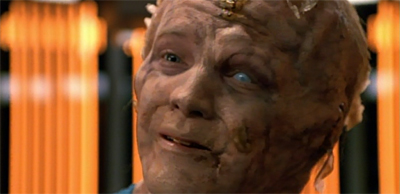
“Hey! The Emmys think this is better than The Visitor! C’mon!”
Threshold actually works reasonably well as a piece of body horror. It is certainly more compelling as body horror than it is as character study or philosophical treatise. The show is surprisingly discomforting for an episode of Star Trek , with one of the lead characters pulling out his own tongue. The make-up is impressive, even if it leads to the bizarre situation where Threshold beat The Visitor to an Emmy award. Paris rants and raves all sorts of suitably creepy existential nonsense about what he is “becoming.”
Of course, the episode around all this is incredibly lazy and disappointing. There are any number of credible criticisms of the plot, right down to the principles underlying Paris’ transformation. Quite simply, evolution does not work that way. Evolution is not a linear process that can be magically accelerated. Evolution occurs through natural selection and genetic diversification; there is not a magic “go faster” button buried in DNA that might speed things up. For a show that claims to be science-fiction, Star Trek sure has a shoddy understanding of evolution.
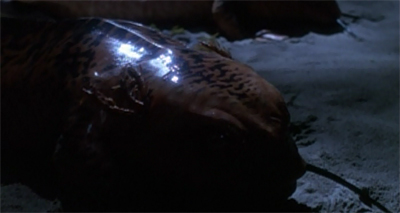
Evolved sensibilities…
Star Trek tends to adopt a very deterministic approach to evolution. According to Star Trek , evolution is not a process that results from a variety of external factors – including the surrounding environment and gene pool. Stories like The Chase and Threshold suggest that there is really a predetermined evolutionary path for mankind to follow, a clear and orderly progression between what mankind is and what mankind is to become. According to the logic of the Star Trek universe, evolution is something that occurs with a very clear purpose and objective.
Indeed, this arguably plays into the rhetoric of the Prime Directive as it is articulated in the nineties Star Trek shows. Picard and Janeway are reluctant to interfere with the so-called “natural” evolutionary course of a species, refusing play god. In Prototype , Janeway even suggests extinction is the most likely outcome of any evolutionary path. All of this ignores the reality that evolution is a process that is adaptable and flexible; it does not occur within a vacuum, and often welcomes the arrival of outside influences.

Flight of fancy…
In Captains’ Logs Supplemental , Braga argues that he intended the episode to play as a deconstruction of the idea that evolution was inherently progressive:
It’s very much a classic Star Trek story, but in the rewrite process I took out the explanation, the idea behind the ending, that we evolve into these little lizards because maybe evolution is not always progressive. Maybe it’s a cycle where we revert to something more rudimentary. That whole conversation was taken out for various reasons, and that was a disaster because without it the episode doesn’t even have a point. I think it suffered greatly. I got the note that it wasn’t necessary, but in fact it really had a lot to do with what the episode was about. Big mistake taking it out.
It’s a fair point, but Braga’s central thesis still suggests that evolution is a single predetermined path, albeit one that doesn’t always lead upwards.

Breathing it in…
(As if to demonstrate that Threshold considers evolution to be a singular predetermined path, it is worth noting that apparently Janeway undergoes the exact same transformation as Paris; her “evolution” progresses in exactly the same direction as his own, to the point that the two are able to conceive children together. It appears that Threshold is being rather unambiguous here; those salamander creatures are the natural end point of human evolution, folks. Don’t worry that it doesn’t make any sense.)
In a way, Threshold could be seen as an example of the Star Trek franchise’s somewhat reactionary anxieties about transhumanism. For a property that claims to offer a utopian vision of the future, Star Trek is frequently terrified by the idea that anything could exist “beyond” humanity; humanity is presented as something approaching the pinnacle of evolutionary design, and any attempt to transcend that is inherently abhorrent. The future might hold infinite possibilities, but they are possibilities to be explored by good old standard-model humans.

“Yes. I’m sure the Kazon – of all people – will be able to put this knowledge to good use.”
The franchise has been wary of attempts to genetically enhance humanity, dating back to Space Seed and continuing through to Star Trek Into Darkness . When genetic engineering does not produce monsters like Khan, it produces sociopathic misfits like those featured in Statistical Probabilities . The Borg are portrayed as monstrosities in their efforts to transcend organic life and reach towards “perfection.” It seems that Threshold is embracing this anxiety, suggesting that even evolution itself cannot improve on the basic human form.
Even allowing for the somewhat… questionable evolutionary theory underpinning the episode, the script around the pseudo-science is incredibly weak. Threshold starts out as another “Voyager almost gets home” story, in the grand tradition of Eye of the Needle , Prime Factors and Cold Fire . This time, it seems like the crew of a ship stranded on the opposite side of the galaxy are somehow able to break the fundamental laws of the universe. Well, they certainly have the necessary motivation.
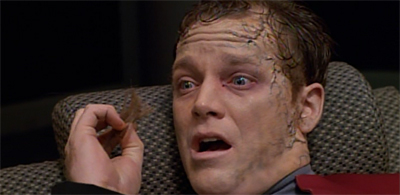
His hair is falling out from the pressure…
Threshold is very much a “Voyager crew redefine the laws of physics and forget about it the following week” story. The crew would often solve seemingly impossible scientific problems, constantly re-writing the textbooks on basic physics and elementary science. Although this tendency was somewhat exaggerated by fandom, there are a number of points where it seems like the Voyager crew devote a few hours of thought to a seemingly unsolvable problem, refine it to the point where it helps them either get into or out of the plot of the week, and then promptly discard the idea.
(This is typically a factor in “crew almost get home” stories, because the nature of Voyager means that the crew cannot get home before the end of the series. As a result, a number of key projects and decisions are motivated by the possibility that the crew might get home, only for the episode to handwave a reason why they can’t actually use the technology or research to get home. In Prime Factors , they try to use the Sikarian technology once; when it proves incompatible, the crew make no further investigation into it and conduct no further research.)

The A-Team…
It does seem weird that Voyager is apparently populated with the sort of hyper-competent individuals who put the crew of the Enterprise to shame. Picard assembled his crew from the best of the best to staff the Federation flagship, it makes sense that Geordi LaForge and Data would be among the best and the brightest. In contrast, Caretaker suggested that the crew of Voyager were a bunch of rogues and neophytes thrown together by circumstance. It seems weird that so many breakthroughs should come from throwing these characters together.
After all, the team that crack “warp ten” are hardly a collection of Starfleet all-stars. Tom Paris was a hotshot pilot who was not skilled enough to avoid detection when he became a terrorist; Harry Kim is just a child. The only person on the team whose specialty is actually warp travel is only one who never actually graduated from Starfleet Academy. It seems weird that Torres should prove so skilled at theoretical physics when the show has made so much of her practical prowess.

“It was all a holodeck simulation. Let’s go with that.”
In Threshold , the crew develop a new technology that allows them to be everywhere in the universe at once; it has a fairly useful application for a crew stranded on the other side of the galaxy. In his initial test, Paris starts and ends in the same place; however, his later adventure with Janeway suggests that it is possible to enter and exit transwarp at different locations. (Although it is convenient that he stays within range of Voyager.) This could be a vital part of getting the crew home, with a bit more research and development.
Sure, the technology has some unfortunate side effects, like turning people into lizards. However, the closing scene of Threshold suggests that the EMH has found an effective treatment for that potential issue, as reverting Janeway and Paris to their human forms is no big deal. Why can’t Voyager make the jump, and then have the EMH treat the crew afterwards? It seems like the transformation from human to lizard takes quite a bit of time, so the EMH certainly has a window of opportunity; particularly if he has an effective treatment.

“Or a dream. It could all be a dream prompted by Neelix’s new coffee blend.”
If there are factors like Samantha Wildman’s pregnancy to consider, why not send a shuttle with one person (and details of the treatment) to Earth to let them know Voyager is alive and to give them the transwarp research? Why not continue research into transwarp with an eye to preventing the sudden evolution of the crew? There are any number of ways that the events of Threshold should get Voyager at least a little closer to home, although the show can’t be bothered to do anything with them.
There is a reason for this, of course. The second season of Voyager is absolutely abysmal at arc-based storytelling. Even leaving aside the question of how quickly the crew forsake the possibility of using transwarp to get home, Threshold wreaks havoc with Tom Paris’ arc across the second season as a whole. Threshold is essentially an episode about how Paris has to become comfortable in his own skin, coming right before Paris starts roleplaying as a lovable rogue in an effort to get himself kicked off the ship and recruited by the Kazon.

“Starfleet is NEVER going to believe this.”
Discussing Threshold with Cinefantastique , actor Robert Duncan McNeill explained how he tried to root the episode in a simple character arc for Tom Paris:
What is this about? Before you can even start to tell the story you have to find the moral. What is the simplest point of this episode? Once you can say that in a sentence then that is what the episode is about. To me that the whole warp ten and salamanders and all of that frosting was about Paris trying to find some sort of salvation outside himself and ultimately realizing that he had to find his own self worth from within. Here is somebody who thinks he’s got to break warp ten and prove to everybody, his father and himself that he can do this outside thing, but ultimately your happiness comes from within.
It is a fairly generic character arc for Tom Paris, particularly heaped upon an episode that is already as tonally messy as Threshold .

In the horror vein…
At the same time, the theme kinda works with the episode’s body horror themes; Tom Paris finds himself transforming into a monster, perhaps reflecting how he sees himself – or how he suspects other see him. “What I’m becoming will probably be better than who I was,” Paris confesses to Janeway in a moment of self-pity. However, the theme is never quite as developed as it needs to be for the story to work. Instead, it feels like a concept grafted on in an attempt to give the episode some emotional heft.
The episode ends with Paris coming to the realisation that he needs to be comfortable in his own skin. “I guess I went into this looking for a quick fix,” he confesses. “I thought making history would change things. Not just my service record, my reputation.” Janeway assures him, “If I’m not mistaken, you’ve changed quite a few minds on this ship. You’ve earned a lot of people’s respect and admiration.” Paris responds, “Yeah. But I’m starting to realise that it’s not other people’s opinions I should be worried about. It’s mine.”

Engineering a solution…
It is a sweet – if corny – sentiment. Unfortunately, it is completely undercut by Paris’ character arc across the next few episodes. Starting with Meld , Paris reverts back to his bad boy ways and starts squandering all the good will that he has built up. In Investigations , it is revealed that this is all part of a secret plan to infiltrate the Kazon and expose Michael Jonas. Ignoring the terrible execution of the arc, which pretty much killed any possibility of Voyager embracing serialised storytelling, it is an interesting concept.
The problem is that the handling of Paris across the rest of the season jars completely with the central point of his character arc in Threshold . Threshold insists that he is appreciated on Voyager and that he can be comfortable enough to stop playing the feckless rebel. There is a way to rationalise Paris’ character development in Threshold with his treatment across the rest of the season, but it would require a fundamental reworking of the season arc. As it stands, the arc is incompatible with the character work here.

“Hey, why are you guys all sitting away from me?”
Then again, it comes down to one of the fundamental problems with the second season’s use of Paris. Having Paris act like a jerk for no reason, before revealing the reason as a twist, is a terrible creative decision; it feels lazy and ill-judged, prioritising the twist ahead of the character. It might have worked better to be upfront with the deception, exploring the arc from the perspective of Paris himself. There are many issues with the Paris arc that runs through season, but the fact that it doesn’t actually develop Paris’ character is one of the most striking.
Having Janeway pitch the ruse to Paris, and having Paris decide that he is willing to throw away all the goodwill he has earned to protect the crew, would be an organic continuation of his arc in Threshold . The closing scene of Threshold has Paris suggest that his own esteem is more important than that of anybody else on the crew; watching Paris make that choice would be an interesting dramatic beat. Of course, this does nothing to resolve the many other problems with the arc; most notably, Janeway and Paris still violate the trust of the senior staff – especially Chakotay.
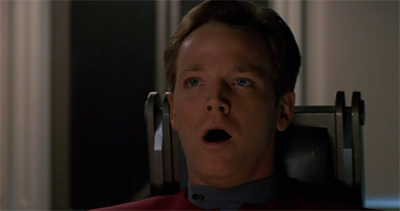
“Oh, boy…”
There are other stock problems with Threshold . As with a lot of Voyager scripts, flimsy science (and hazy internal plot logic) are hung on technobabble. The show offers a variety of gobbledygook to explain what is happening (and how the EMH plans to fix it) but none of it is actually convincing. “I’d like to place Mister Paris in an isotopic restraint and then infuse it with controlled antiproton bursts,” the EMH explains. “A tricky venture, but I see no other alternative.” It is hard to generate tangible stakes when dialogue comes out of a technobabble generator.
At the same time, there are some interesting concepts. The idea of transwarp allowing Paris to be everywhere at once is quite interesting, in a vaguely spiritual sort of way; the ability to occupy every space in the universe in the same instant is something almost beyond human comprehension; it suggests a state of “oneness” with the universe. In fact, it invites the viewer to wonder whether beings like the Q evolved in a similar fashion, transcending the boundaries of space (and even time) to be everywhere at once.
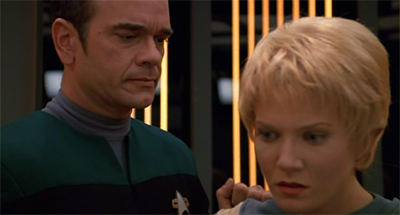
“Don’t worry. In a week, it’ll be like this never happened.”
Paris’ description of the experience is romantic. “I was… I was staring at the velocity indicator. It said warp ten. And then, as I watched it, I suddenly realised that I was watching myself as well. I could see the outside of the shuttle, I could see Voyager, I could see inside Voyager. I could see inside this room. For a moment, I was everywhere. I mean, everywhere, Captain. With the Kazon, back home, with the Klingons, other galaxies. It was all there. I don’t know how else to explain it. It was like. Well, no, it wasn’t like anything.”
Star Trek is a show that is about exploration, and Voyager was very consciously an attempt to get back to the art of exploring. However, that exploration is as much about interrogating the human condition as it is about charting literal new frontiers. The use of transwarp as a means to connect mankind to everything in the universe and to transcend linear perception does both at the same time; it suggests an evolutionary leap in the type of “exploration” that is possible on Voyager . Too bad that it ultimately ends up as an episode about lizard babies.

“But my next character-centric story is better, right?”
(Then again, it is hard to imagine what the dramatic stakes might have been in a story about the crew achieving “oneness” with the wider universe. Where does that particular story go? What happens when you are literally everywhere at once? As Death Wish suggests, omniscience can be boring. At best, this alternate version of Threshold might have played out in an abstract manner that recalled Where No One Has Gone Before . Given how Threshold ultimately turned out, that might not be such a bad thing.)
Threshold is not a good episode of television. It is, in many respects, quite terrible. However, it is not as terrible as its reputation suggests; it is not as terrible as the episode that aired directly before it. It doesn’t even come close to working, but it is not even the worst episode of this season.
Share this:
Filed under: Voyager | Tagged: Brannon Braga , evolution , horror , posthuman , salamanders , star trek , star trek: voyager , threshold , tom paris , voyager , warp 10 , warp ten |
27 Responses
>The episode is terrible, but there were so many terrible episodes airing around it that it seems weird to focus hatred on this individual story.
To address the two you cite – I simply found “Tattoo” boring and loathed “Alliances” for the message that compromise is bad.
“No. Not even in the face of Armageddon. Never compromise.”
I didn’t pause to consider the racial problems in either program because it requires time to pause and consider the subtext of what was going on. I didn’t grasp that “Tattoo” had said the First Nations were special because of white men until SFdebris pointed it out and didn’t notice Voyager asked the slave owners for help against their former subjects until your own worthy observations.
To me, “Threshold” irritated me instantly because of the bad science.
>Braga is the first to admit that Threshold doesn’t work:
Well, *now* he bows to popular opinion. He was much more defensive in the 90s.
>Picard and Janeway are reluctant to interfere with the so-called “natural” evolutionary course of a species, refusing play god. In Prototype, Janeway even suggests extinction is the most likely outcome of any evolutionary path. All of this ignores the reality that evolution is a process that is adaptable and flexible; it does not occur within a vacuum, and often welcomes the arrival of outside influences.
“I did the right thing, didn’t I? It all worked out in the end.” “‘In the end’? Nothing ends, Adrian. Nothing ever ends.”
(on a Watchmen kick, obviously)
>After all, the team that crack “warp ten” are hardly a collection of Starfleet all-stars.
You don’t even mention the crucial breakthrough which solved the engineering of infinite speed came from ***Neelix***.
Ha! “Neelix: The Man Who Cracked Warp Ten!” It sounds like a Federation documentary waiting to happen. Or like a fictionalised “Breakfast with Neelix” film waiting to happen. (“Neelix, your ratings are huge!” “Well, I am the only thing on.” “Still, check out that market share!”)
All these years later I still remember this one… unfortunately!
I think that the reason why I specifically hated this episode so much was because for me it so perfectly epitomized the major failing of Voyager. Let me explain…
In the next-to-last scene, Paris and Janeway have evolved into weird non-humanoid lizards, have mated, and have produced offspring. The rest of the crew finds them and brings them back to Voyager. Then, just one scene later, they are both completely back to normal, with seemingly little-to-no effort needing to be expended to restore their humanity. It was the most egregious example of hitting the reset button that I had seen in a very long time.
And that, for me, was the cardinal sin of Voyager: it promised that it would go in completely different directions, do things never been done before in Star Trek, push the characters in uncomfortable directions, yet it was always hitting reset, always ending every single episode with the status quo completely restored. No matter how bad things got, at the end everything got put back perfectly in the box.
I guess I also had the same problem with “Year of Hell.” That, at least, was a good episode… except that at the end inevitably the writers had Janeway alter history completely erased all the events of the story, once again returning things back to business as usual.
Another example would be deadlock. I think it is an excellent episode, but at the end Voyager is a steaming wreck of a ship. The next episode though everything is hunky dory.
I think it’s funny that in Alliances, Chakotay said Voyager had taken so much damage they’d be lucky to ever get warp drive back online again. And now in Threshold, they’re working on a way to get the ship up to Warp 10 and travel at infinite velocity. Yeah, Voyager is fond of the reset button, but some have thought that the production team were so ashamed of Threshold they actually erased it from canon. That may have been why in Day of Honour, Tom claims to have never travelled at transwarp before.
Yep, that’s the episode I was thinking of. I knew Tom made a remark like that at some point, I just couldn’t remember where exactly.
“Tom and Janeway have lizard sex” is Brannon’s entire work, ‘in ovo’ as they say in Latin.
a) the episode is goofy and makes no sense, existing solely to reach the desired outcome of Tom/Janeway lizard sex
b) it’s kinky but in a passive sort of way, as we can’t get away with normal sex on Star Trek.
c) Janeway assets her sexual dominance over Tom, another one of Braga’s thumbprints
d) it leaves the audience wanting to take a cold shower.
Braga’s sexual fixation is interesting, if only because it’s very adolescent. (In many respects, Seven of Nine is a teenager’s blonde ice queen fantasy brought to life, particularly early in her life.)
I remember Braga’s infamous interview where he tried to paint himself as the “bad boy” of the TNG writers’ room by talking about how “kinky” he was. (If I remember correctly, this was the same interview he boasted about never watching TOS.) I’m actually quite fond of Braga as a science-fiction and mind f$!k writer, but he should probably stay away from sexual themes.
I do feel a little hypocritical here. I am a major critic of the “reset button” trope as a reflexive force of habit, as it became for Voyager from this point onwards. In fact, I think Deadlock really establishes a template, and Year of Hell is another glaring example. However, I really like both Deadlock and Year of Hell, in spite of their reset button endings. Indeed, to the extent that the only way those stories become possible on Voyager because of the reset button endings, you could argue I really like them because of the reset button.
(Hell, I even kinda like Course: Oblivion, more for the idea than the execution.)
None of which negates your criticisms, which I largely agree with and I suspect I’ll make in due course. (I think I’ve alluded to similar sentiments in earlier reviews.) But it is a nice example of how conflicted I am on the subject of Voyager.
I agree that this is not the worst voyager episode ever made, as at least it has an Ed Wood or Tommy Wiseau quality to it. The audience just wants to keep watching to see how ridiculous it gets and by God does it ever succeed. What are your thoughts on Genesis? The plot is equally ridiculous, but I thought the atmosphere was much more successful. It made me wish Gates McFadden had been given a better script.
I am a big fan of Genesis. I loved it as a kid, and I enjoy it now. And I love Phantasms. And I adore Masks. I loved it as a kid and I love it even more now.
And I find Sub Rosa fascinating. Not good, necessarily, but fascinating.
I find a lot to like in the seventh season of The Next Generation.
Yeah, if anything, “Threshold” was a blessing for Voyager. Because it misdirected hate went into this episode, far more than was deserved.
Which neatly avoids the malign racism and anti-intellectualism that went into seasons 1-2, and Voyager ended up looking much better in the end tally. Threshold is an easy target. The rest is too esoteric to break into soundbites.
It’s not even Braga’s worst episode – “Primeval” is a stiff contender, ironically being a hasty rewrite of Threshold. What can we say. Brannon is none too bright! (Which is why we love him.)!
“…ultimately your happiness comes from within.”
You might say it was his…. “greed for knowledge” that led him to this place? https://them0vieblog.com/2013/03/29/doctor-who-planet-of-the-spiders-review/
The funny part is, this isn’t even Robert. He’s not wringing meaning from a bad script. The holistic reading is baked into this episode. We’ll see it again when Darren gets to “The Fight”.
If you’re an aficionado of bad sci-fi, it starts to become a giant ‘red flag’.
It means the science has broken down, the story makes no sense, and the writer is desperately trying to pass the whole thing off as “Zen”.
Sorry, I meant Extinction.
To be fair to Braga, I think Extinction is Bormanis. But it happened under Braga’s watch, and he rightly acknowledges it as a stinker.
That said, I actually consider Extinction worse than Braga’s two (or three) evolution-themed episodes, because it veers right into racism on top of the awkward sexual politics, but without the campy fun of “Spider Barclay!” or “Toad Tom!” or “Super Virus!”
I like the idea of foreshadowing my reviews three seasons down the line! (Although we may be a ways away.)
And good spot on the anti-intellectualism. I hadn’t quite twigged that, but it’s definitely there.
I have to admit I always found something romantic to the idea that the misfits and malcotents on DS9 and Voyager might be better at thinking outside the box than the staid hyper professionals that make up Picard’s crew.
Tom Paris’ omnicompetence is a running gag on SFDebris but there is something appealingly individualistic in the notion that he and B’elanna Torres are brilliant mavericks who in normal situations would never last inside a Starfleet uniform. If only the execution had lived up to that!
So, Voyager didn’t go just missing — they’re going Galt!
That’s Voyager in a nutshell. “If only the execution had lived up to that!”
I always wondered why Threshold received the worst episode status, SFdebris even said it was the worst Star Trek episode of the franchise until Enterprise. This puzzles me because this episode isn’t painful to watch, it isn’t racist or sexist propaganda, and none of characters so damaged, that they are beyond redemption. It really does feel like the only thing that failed about this episode is the stupid, stupid script, I daresay the wrongness of the science rivals that of Star Trek 09.
There’s something really sad about this episode, you can tell people are trying, Robert Duncan McNeill is going all out in his performance and you can tell the costume people are doing their best, all to be thoroughly wasted with Braga’s script. Still, I’m a sucker for high-concept stories and when this first aired, I had never considered the possibility of infinite speed, or say, the benefits of having two hearts (didn’t know about Doctor Who yet). Which, as an aside, doesn’t infinite speed sound insanely dangerous? If you occupy every part of the universe at the same time, doesn’t that mean you’ve destroyed the universe? Or become the universe? I don’t blame Starfleet for not trying to pursue such dangerous concepts.
Overall, I do find that because there is some competency in this episode, and the people behind it are clearly trying (heck, they won an emmy), that I can’t even call this a “worst” episode of anything, it’s just a big misfire. Watching this episode and witnessing Tom mutate into a monster, you never felt the urge to gouge out your eyes, unlike say, in Profit in Lace, where we see horror made flesh with Quark with boobs wearing a dress in the style of Colin Baker’s Doctor *shutter* and watch as other Ferengi try to grope him *vomit*. There’s also some real tension/anxiety in this episode, it is as if the transformation process is intentionally mirror what it’s like to die slowly from a lethal dose of radiation. At first you only experience subtle differences, but because your DNA is irreparably damaged, you are robbed of your humanity in your last days/hours as your skin and hair fall away, your tongue swells and what’s left of you is barely recognizable. You can understand why Tom reacts in despair the way he does, it is a gruesome death and the Doctor’s helplessness and confusion is palpable. That said, whatever good this episode has vanishes by the time we reach acts 4 and 5. Even Captain Proton would scoff at the silliness and stupidity.
Yep. In a season that includes Tattoo and Alliances, it seems strange to single Threshold out. And there are logical problems with this, but they’re really just an extrapolation of the logical problems that come baked into the franchise. (Which is appropriate; if transwarp is warp to the power of infinity, it makes sense that its logical inconsistencies and insanity should be equivalently scaled up from the already ropey science of warp speed and transporters.) But you’re right that MacNeill gives it his all.
Something I’m surprised that hasn’t been touched on in these discussions about why “Threshold” is so hated is the possible squick factor. It’s always summarized to me as, “Paris and Janeway turn into salamanders and have sex!” Even though it’s not onscreen as opposed to the appalling racism in other episodes, it’s exactly the kind of thing that easily elicits a visceral reaction from an audience and magnifies their dislike of the episode. Probably more so if you consider the strain of Puritanism that runs deep in American culture.
(Of course what does this say about the fact that Tattoo and Alliances didn’t elicit similar disgust?)
That’s fair.
As somebody pointed out when I remarked that Alliances and even Tattoo get a pass while Threshold doesn’t: it just depends on your tolerism for racism as compared to sexual assault .
I have a certain fondness for Threshold. Threshold is terrible, but it’s terrible in a bold, exciting way. There was a lot of painful mediocrity in Voyager, particularly the second season. And, as you note, much of it was offensive and tedious at the same time, which is the worst of both possible worlds. Threshold was offensive, but decidedly not tedious, which made it stand out, I think. I’ve seen pretty much every Voyager episode, and so many of them seem to melt together. However, the story beats of Threshold–warp 10, transformation, death, tongue falling out, kidnapping, salamander babies–stick out in my memory. I couldn’t tell you what happened in Tattoo or the Kazon episodes.
I’m kind of reminded what the elderly matriarch of the Wagner family said in re: the very controversial centennial staging of the Ring cycle: “Isn’t it better to be furious than bored?”
And I’d even argue that Threshold’s badness is generally inoffensive compared to Alliances or Tattoo. Isn’t it better to be gonzo than casually racist?
Maybe it’s the prurient nature of the ending that threw people off. For whatever reason, there’s perhaps an expectation of cultural tone-deafness and casual racism in Star Trek; thus, fans can view something as objectively offensive as the Kazon with boredom. But throw in an aspect of bizarre sex, and that drags your standard nerd out of his comfort zone and onto his high horse.
That might be it. There are certain sides of fandom that I will never completely understand.
I like that you try to redeem this episode which I fin rather boring. It could have been way more intriguing, especially Paris’ outline of his transwarp experiences could have had some kind of “2001”-ish feeling to it – especially given the theme of evolution. You are quite right about your observations and I guess it all comes down to Star Trek’s rather old-school enlightenment vision of humankind and progress which is only a bit at odds with its bio-conservatism which still suggests that the highest form of evolution is mankind and progress is observed by humans for eternity, everything fitting nicely into a system – even if there might be potential drawbacks like humans (d?)evolving into lizards. Still, I do like this bio-conservatism somewhat… it seems to respect human dignity more than anything we are even experiencing now.
Regarind the illogicity of the ending: Well, it had to be that way for Voyager not returning home too early. And the story barely manages to ignore that because it was so bad overall.
Leave a comment Cancel reply
This site uses Akismet to reduce spam. Learn how your comment data is processed .
Recent Posts
- 373. Pirates of the Caribbean: The Curse of the Black Pearl (#225)
- 371. Poor Things (#246)
- 370. Dune: Part Two (#12)
- 369. Memento (#57)
- 368. Monty Python and the Holy Grail (#154)
Recently tweeted…
- "I Simply Am Not There": The Existential Horror of Eighties Excess in "American Psycho"...
- Star Trek: The Original Series (Reviews)
- The X-Files - Monday (Review)
- "The Things You Gotta Remember Are the Details": Reservoir Dogs and the Fragility of Memory and Meaning in the Nineties...
Available at…

Blogs Well Worth Your Time
- 1001 Must See Films
- Andrew at the Movies
- Anomalous Material
- Cut the Crap Movie Reviews
- Encore Entertainment
- Fandango Groovers
- FlixChatter
- Four of Them
- It Rains… You get Wet…
- Jameson Cult Film Blog
- Jar Watches Films
- Let's Go To The Movies
- M. Carter at the Movies
- Marshall and the Movies
- Movie News First
- Musings from a Man Lost in La Mancha
- Never Mind Pop Film
- Paragraph Film Reviews
- Roger Ebert's Journal
- Ross v. Ross
- Scannain.com
- Screenwriter (Donald Clarke, Irish Times)
- Strange Culture
- The Film Cynics
- The Pompous Film Snob
- The Projection Booth
- Things That Don't Suck
- Too Busy Thinking About My Comics
- Undy a Hundy
Film Nerd Resources
- CinemaBlend (News)
- Internet Movie Database
- Rope of Silicon
- The Guardian Film Blog
- James Berardinelli
- Roger Ebert
Email Subscription
Enter your email address to follow this blog and receive notifications of new posts by email.
Email Address:
Sign me up!
Blog at WordPress.com. WP Designer.
- Already have a WordPress.com account? Log in now.
- Subscribe Subscribed
- Copy shortlink
- Report this content
- View post in Reader
- Manage subscriptions
- Collapse this bar
Star Trek: Voyager (TV Series)
Threshold (1996).
- User Reviews
- So, of all the ships in the galaxy that have had warp drive it is the USS Voyager out in the Delta quadrant without a team of high IQ professionals working on warp drive theory manage (over lunch) to crack this case?
- If we are not sure what will actually happen after warp 10 is achieved how about putting the shuttle on auto pilot and recording the results instead of putting Tom Paris is an unknown situation?
- Why was the reasoning behind Tom Paris kidnapping Janeway?
- Wait a sec, didn't Tom Paris get jail time for pulling a crazy shuttle maneuver in the academy?
- So, when Janeway broke the warp 10 barrier she instantly turned into a Lizard and didn't go through the 24 hour evolutionary cycle that Tom Paris did?
- What type of space magic did the doctor use to change Tom and Katheryn from electric Lizards into flesh and blood human beings? Give that man a medal of freedom for this achievement.
Awards | FAQ | User Ratings | External Reviews | Metacritic Reviews
- User Ratings
- External Reviews
- Metacritic Reviews
- Full Cast and Crew
- Release Dates
- Official Sites
- Company Credits
- Filming & Production
- Technical Specs
- Plot Summary
- Plot Keywords
- Parents Guide
Did You Know?
- Crazy Credits
- Alternate Versions
- Connections
- Soundtracks
Photo & Video
- Photo Gallery
- Trailers and Videos
Related Items
- External Sites
Related lists from IMDb users

Recently Viewed
- More to Explore
- Series & Movies
Published Jan 10, 2022
Janeway, Fair Haven and the Romantic Making of A Heroine
In the eyes of one fan, the infamous "Fair Haven" saw Janeway at her strongest.
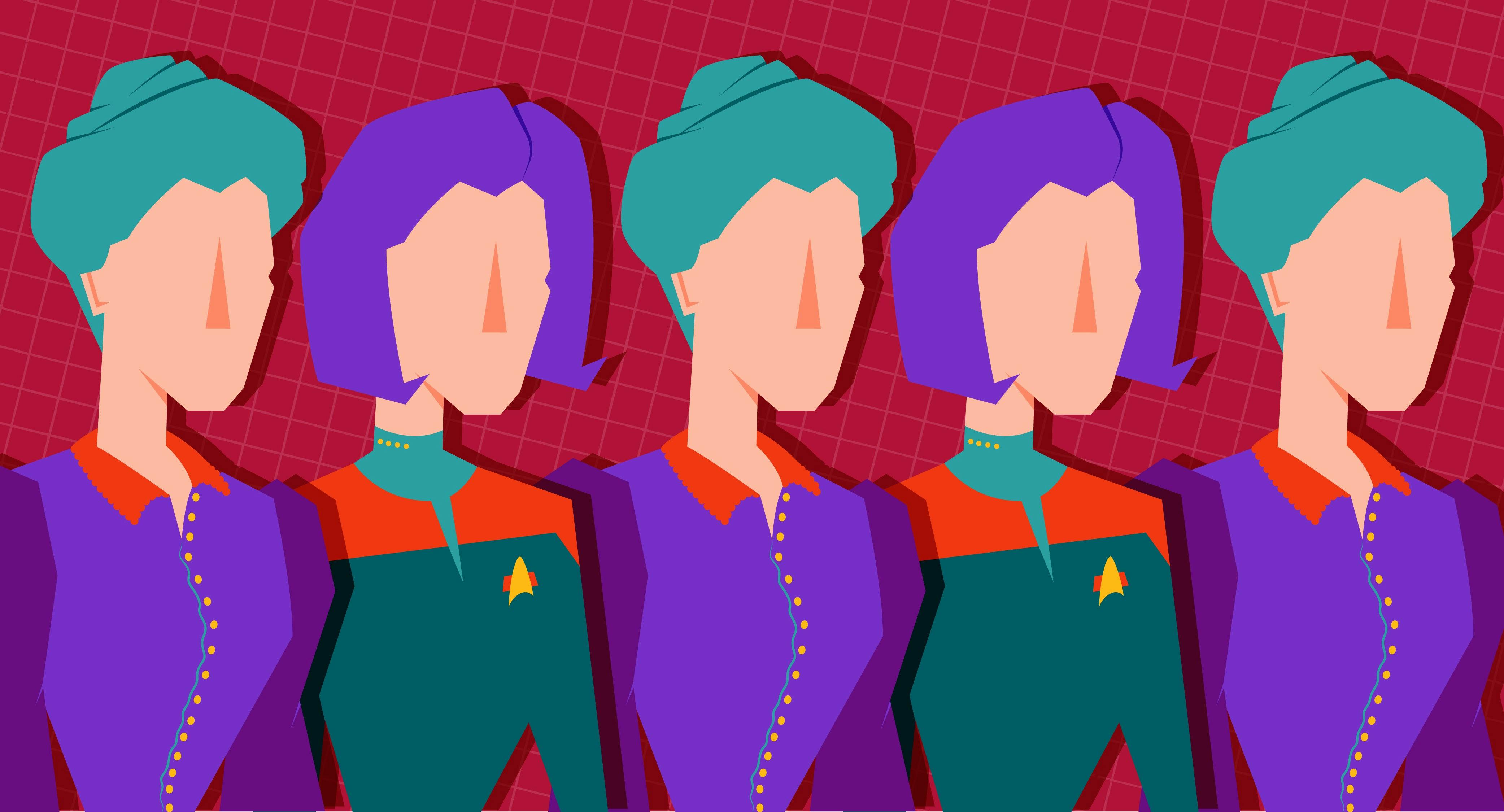
StarTrek.com
In a genre as vast, and intellectually and artistically curious as science-fiction the possibilities for plot lines are as endless as the various universes one can create. With an exponential number of lanes to explore, the chances are that any long-running series will produce a few episodes that reach a certain level of infamy within the fandom.
Perhaps no series better exemplifies this principle than Star Trek: Voyager , a series in which Captain Janeway and Tom Paris became copulating lizards due to a freak accident; and where the ship’s logical Vulcan, Tuvok, physically melded with the colorful morale officer, Neelix, leading to a great in-episode debate on the very nature of being. Within internet circles, Star Trek: Voyager ’s “Fair Haven” has gained a similar level of infamy, frequently ranking on the web’s various "Worst of Voyager " lists, with the main reason cited that it’s “Just a romance novel.”
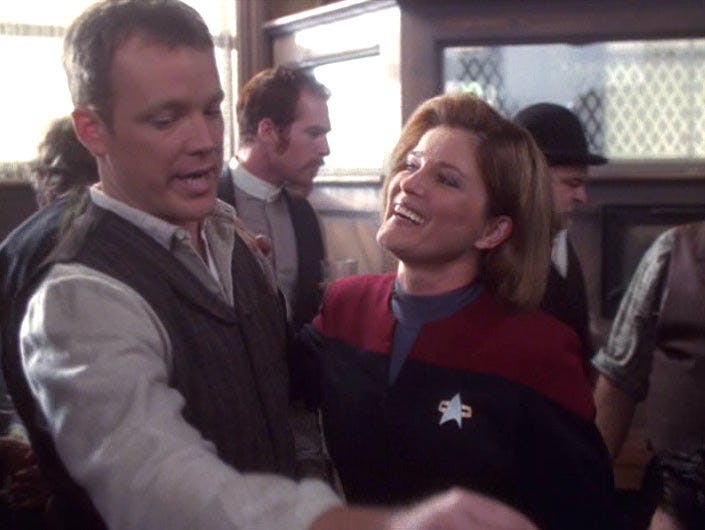
But is that necessarily a bad thing? Or is styling Captain Kathryn Janeway as a romance novel heroine, simply adding another layer of complexity to an already richly developed, fascinating, strong female character? For a woman who has spent six years with only a glimmer of hope towards finding her home, isn’t spending a few hours as the heroine in a romance novel, a genre defined by its focus on joy and on female fulfillment, really such a terrible development?
In season six’s “Fair Haven” the ship is about to fly through an ion storm just as Tom Paris is putting the finishing touches on his new Holodeck program — the small, early 20th-century Irish town of Fair Haven. In an effort to ride out the storm, Captain Janeway makes the decision to drop anchor and (in an effort to increase ship morale while they wait) initiates an open-door policy on the Holodeck, a privilege she tentatively enjoys herself as an escape from her own fear of storms.
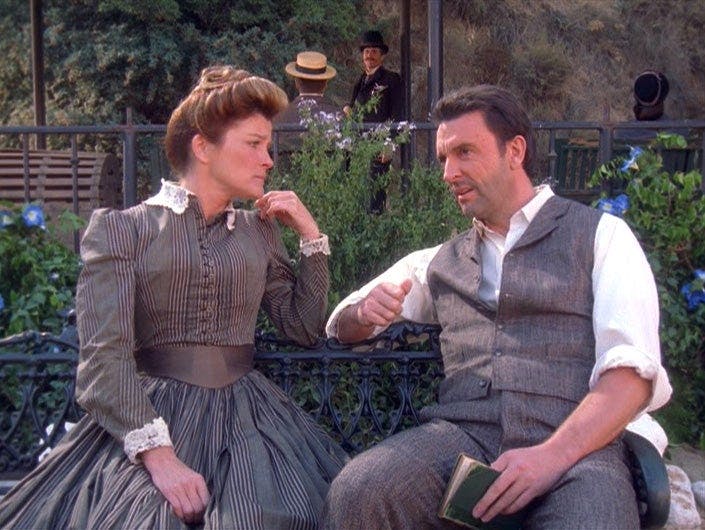
In the town, Janeway finds solace with a charming man who isn’t exactly her type, the barkeep Michael Sullivan. She “slightly” alters his physical and interpersonal parameters to make them more compatible, describing it jokingly as, “Girl meets boy, girl modifies boy's subroutines.” Her tinkering eventually leads to a crisis of conscience, where Janeway is at once conflicted about enjoying a romantic entanglement with a hologram and with modifying that hologram out of her need to control and “captain” every situation she faces.
Implicit in much of the criticism of “Fair Haven” as an episode is the proposition that all romance novels are Bad and that people who read and enjoy them are also Bad. Janeway, who experiences the Fair Haven simulation and her relationship with Michael Sullivan as many romance readers do — by putting herself in the shoes of the romantic heroine — is suddenly Bad too, or at least finds her strength somehow lessened in the eyes of viewers because of her engagement with this material. Even Kate Mulgrew herself, in an infamous hidden clip from the Voyager box set, disparages the entire plotline, visibly shivering as she describes her character “falling in love” with a hologram.
There have been many articles, essays, think pieces, and books defending romance novels and giving it the respect it deserves as a literary genre. I won’t do that here. But it doesn’t take a fistful of think pieces to understand why "Fair Haven" further illuminated how much Janeway meant to me as a character.
According to most genre experts, including Sarah Wendell of the website Smart Bitches, Trashy Books, A romance novel needs to meet two guidelines. First, the main thrust of the story needs to concern two characters falling in love. Second, that romance needs to find a Happily Ever After, also known as HEA in romance circles. According to Sarah Wendell and Candy Tan’s Beyond Heaving Bosoms, “Romance means believing you are worthy of a happy ending.” If we agree with the premise that most “Fair Haven” detractors suggest, then I say it makes Janeway one of the strongest characters in the Star Trek universe. Because after six years of separation from her home with no end in sight, Janeway is still able to give herself over to the possibility of romance.
Despite all that she’s endured and that her crew has endured over six years in the Delta Quadrant, the captain retains the optimism that everything will work out fine in the end. She gives herself over to the idea that she deserves a happy ending, a belief that extends beyond the walls of the Holodeck, beyond the hull of Voyager, and beyond the Delta Quadrant.
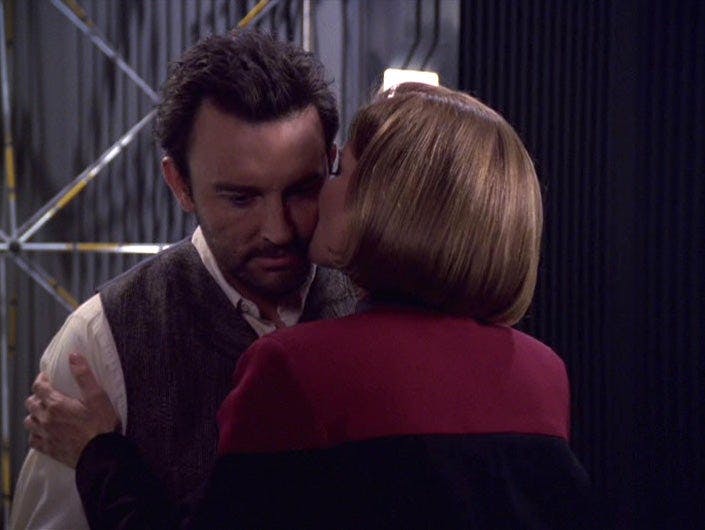
Some may say that “Fair Haven” was the death of Captain Janeway as a strong female character, but as far as I’m concerned, it might have been the most inspirational she ever was.
Alys Murray is a romance novelist with a particularly geeky style. She can be found on twitter @writeralys . Tobey Maguire is her Spider-Man
Get Updates By Email
Screen Rant
Ds9 proves star trek: voyager producer was wrong about season 3's prison episode.
Star Trek: Voyager producer Ken Biller had trouble with a season 3 episode, but DS9 proved there was no need to struggle with a similar premise.
- Both Star Trek: DS9 and Voyager showcase similar prison episodes, but DS9's story was more effective
- Voyager producer Kenneth Biller initially struggled with making Harry Kim and Tom Paris' mental deterioration believable in Voyager's "The Chute."
- Voyager used alien technology as a plot device to explain their mental state effectively but could have looked to DS9 for guidance.
One episode of Star Trek: Deep Space Nine proved that Kenneth Biller was wrong about the challenges of Star Trek: Voyager 's season 3 prison episode. Voyager and DS9 were sister shows in the Star Trek timeline , running concurrently with each other for several seasons. Although there was a lot of similarity between the two show's creative teams, producer and writer Ken Biller only worked on Voyager during the 1990s era of the Star Trek franchise.
One early Voyager episode that Biller worked on was season 3, episode 3, "The Chute," a dark story revolving around Tom Paris' (Robert Duncan McNeill) and Harry Kim's (Garrett Wang) time in a brutal alien prison. After being falsely accused of a terrorist attack, Kim and Paris were held in the prison while the USS Voyager's crew worked on a way to save them. Biller found writing the episode a challenge for one specific reason , but could have looked to a similar DS9 episode for the blueprint of how to make the story work.
Star Trek: Voyager Cast & Character Guide
Ds9 proved that ken biller was wrong about star trek: voyager’s kim and paris prison episode, ds9 did a similar episode that pulled off what biller found challenging.
Biller thought Tom and Harry's mental deterioration in prison wasn't believable given the short length of time they were incarcerated, but DS9 and the character of Miles O'Brien (Colm Meaney) proved that severe mental degradation was possible thanks to a particular sci-fi concept. Perhaps because Biller wasn't the original creator of "The Chute," he found the story challenging to pull off and discussed his ups and downs during the writing process with Cinefantastique shortly after the episode aired. Read Biller's full quote about "The Chute" below:
"It was sort of a left-over story from the Michael Piller era, and I struggled with it because it was a prison picture essentially. Michael wanted this to be an episode about Kim's humanity being tested. I thought it was basically an impossible task, because every single prison movie that has ever been successful that I can think of depends on one thing in particular, which is the passage of time. All take place over years, if not decades. Given the fact it would be impossible given the restrictions of our show to strand Paris and Kim for more than several days, it seemed therefore impossible to bring Kim to the brink."
On the surface, Biller's frustrations with "The Chute" are understandable. However, DS9 aired season 4, episode 19, "Hard Time," earlier that same year, which followed Miles O'Brien's recovery from his memories of a 20-year prison sentence. Rather than actually serving 20 years, O'Brien's memories had been implanted and altered to make the passage of time feel longer. O'Brien's incarceration and circumstances were extremely similar to Kim and Paris, and Biller could have used "Hard Time" as an example of how to make their mental states believable in "The Chute's" condensed time frame.
How Star Trek: Voyager’s “The Chute” Still Managed To Make Kim And Paris’ Mental Deterioration Believable
"the chute" made its plot work with a different story device.
As it was, Biller ended up using a different device to make Kim and Paris lose their minds, in the form of alien technology that was specifically designed to make prisoners more aggressive and paranoid. This had the desired effect and was perhaps even a good choice for the episode, given that copying DS9 so soon after "Hard Time's" release could have felt repetitive . However, Biller's frustration with "The Chute's" contrivances wasn't warranted, and a quick look at other shows beyond Star Trek: Voyager could have alleviated some of his concerns.
Source: Cinefantastique , Vol. 29, No. 6/7
Star Trek: Voyager and Star Trek: Deep Space Nine are available to stream on Paramount+.
Star Trek: Voyager
*Availability in US
Not available
The fifth entry in the Star Trek franchise, Star Trek: Voyager, is a sci-fi series that sees the crew of the USS Voyager on a long journey back to their home after finding themselves stranded at the far ends of the Milky Way Galaxy. Led by Captain Kathryn Janeway, the series follows the crew as they embark through truly uncharted areas of space, with new species, friends, foes, and mysteries to solve as they wrestle with the politics of a crew in a situation they've never faced before.
Star Trek: Deep Space Nine
Star Trek: Deep Space Nine, also known as DS9, is the fourth series in the long-running Sci-Fi franchise, Star Trek. DS9 was created by Rick Berman and Michael Piller, and stars Avery Brooks, René Auberjonois, Terry Farrell, and Cirroc Lofton. This particular series follows a group of individuals in a space station near a planet called Bajor.

13 Times Star Trek: Voyager's EMH Said Bones McCoy's "I'm A Doctor, Not A ..."
- The Doctor, portrayed by Robert Picardo in Star Trek: Voyager, humorously uses Dr. McCoy's catchphrase, "I'm a doctor, not a...", and establishes franchise continuity.
- The Doctor showcases ethical integrity and progression, facing various challenges while maintaining a professional and exploratory purpose.
- Each instance of The Doctor saying McCoy's line highlights character development, relationships, and technology in intricate storylines.
Star Trek: Voyager 's Emergency Medical Hologram (EMH), AKA The Doctor (Robert Picardo), frequently repeated the iconic catchphrase of Dr. Leonard "Bones" McCoy (DeForest Kelley) from Star Trek: The Original Series. Somewhat temperamental and impatient, The Doctor was the Chief Medical Officer of the USS Voyager in the (initial) absence of other medical staff. Evolving considerably over Voyager 's seven seasons, Picardo's Doctor is an essential character who showcases not only creative talents and ability but also ethical and moralistic integrity with a professional and exploratory sense of purpose.
Joining Captain Kathryn Janeway (Kate Mulgrew) and the cast of Star Trek: Voyager on their travels through the Delta Quadrant, Picardo's Doctor is progressive yet demonstrates several qualities that reflect traits or viewpoints from the franchise's past. One such facet is the use of the catchphrase, " I'm a doctor, not a ..." initially made famous by Dr. Leonard "Bones" McCoy in Star Trek: The Original Series . It's a nice nod to continuity, allowing Picardo's technologically unusual character a grounded sense of familiarity and purpose. Here's a look at every time Voyager 's Doctor said Bones McCoy's most famous line.
How To Watch All Star Trek TV Shows In Timeline Order
"i'm a doctor, mr. neelix, not a decorator.", star trek: voyager season 1, episode 5 - "phage".
Star Trek: Voyager season 1, episode 5, "Phage," marks the first instance of The Doctor using Dr. McCoy's famous TOS catchphrase. In an amusing scene between an increasingly frustrated Doctor and an ailing Neelix (Ethan Phillips) , Picardo's determined Doctor administers vital medical treatment following the unexpected removal of Neelix's lungs. Despite his condition, Neelix maintains a healthy spirit and even makes a lengthy list of requests for improved comfort and aesthetic enjoyment, suggesting the addition of " a nice tapestry or a painting " and commenting on the ugly sickbay ceiling. The Doctor remarks that he is " a doctor, Mr. Neelix, not a decorator ," and delegates the requested tasks.
This Star Trek: Voyager season 1 scene showcases the resilience of both characters - each discomforted by their unexpected circumstances and ongoing events yet masking concerns with surface-level frustration and ambivalence. Despite the Doctor's electronic and emotional nature, Picardo's character demonstrates real patience and an appropriately gentle countenance designed to comfort and care for patients.

"I'm a doctor, not a performer."
Star trek: voyager season 2, episode 20 - "investigations".
Appointed as the USS Voyager's official morale officer, Neelix designs an " uplifting and optimistic " daily news program to be broadcast to the ship and attempts to enlist other officers for different segments. The Doctor initially dismisses Neelix's request, saying, " I'm a doctor, not a performer. I don't have time for such nonsense ." Neelix perseveres, suggesting a segment on " healthful living " and suggesting that such a feature might considerably propel the Doctor's celebrity and influence within the crew.
The Doctor later reconsiders and demands two segments from a distracted Neelix the following day: how to keep your nostrils happy and the hidden mysteries of the adrenal gland. Star Trek: Voyager , season 2, episode 20 offers a sentimental insight into the Doctor's slightly nerdy personality and multi-character perspectives on life on board a starship, countering the soft glimpses with an overall plot around espionage and deception.
"I'm a doctor, not a bartender."
Star trek: voyager season 2, episode 6 - "twisted".
An unexpected spatial anomaly interrupts Kes' (Jennifer Lien) surprise birthday party in the ship's holodeck and envelops the USS Voyager with an energy field. The Doctor, attending as the simulated scenario's bartender, clarifies that his presence is primarily in an official capacity and lists several unpleasant potential medical conditions that could arise. As Voyager's communications and technological systems malfunction, the Doctor's attempts to return to sickbay and leave the holodeck are unsuccessful. Having drawn the attention of the overly-affectionate simulated bar's owner, Sandrine (Judy Geeson), Picardo's exasperated Doctor exclaims, " How many times do I have to tell you, Madam, I am a doctor, not a bartender."
It deftly weaves intimate character narratives with grand and perplexing confrontations with the unknown.
The multilayered Star Trek: Voyager season 2, episode 6 is a testament to the show's intricate storytelling. It deftly interweaves intimate character narratives with grand and perplexing confrontations with the unknown. The Voyager crew's collective response to the spatial anomaly, juxtaposed with the holographic Doctor's struggle to return to sickbay and his inadvertent antagonizing of several other holographic characters, adds layers of complexity, amusement, and endearment.
"I'm a doctor, not a voyeur."
Star trek: voyager season 2, episode 7 - "parturition".
The USS Voyager sets course to a planet rich in protein and amino acid readings, dubbed "Planet Hell," to alleviate the ship's growing food issues . Star Trek: Voyager season 2, episode 7 sees essential progression in the characterization of several crucial Voyager crew members and their respective relationships, balancing the more weighty developments with less profound interactions among the ship-board crew.
As Voyager approaches the planet, the Doctor contacts the bridge. Having eavesdropped on a conversation between Captain Kathryn Janeway (Kate Mulgrew) and Commander Chakotay (Robert Beltran) , the Doctor informs them of a skin irritation issue from the planet's trigemic vapors and suggests that automatic EMH inclusion in such discussions would prevent the need for routine eavesdropping to " monitor issues involving the health of the crew." As Janeway questions the frequency of this habit, the Doctor says, " I'm a doctor, not a voyeur. I am programmed to be discreet."
Star Trek: Voyager Series Ending Explained - How The Crew Gets Home
"i'm a doctor, not a counter-insurgent.", star trek: voyager season 3, episode 1 - "basics, part ii".
Star Trek: Voyager 's gripping season 3 premiere episode continues the Voyager season 2 finale as the back half of a major Star Trek: Voyager two-parter . With the bulk of the USS Voyager crew stranded and struggling for survival on a desolate and hostile planet, only a few officers remain on board the starship with 89 villainous Kazon.
The Doctor is not just a hologram - he is a Starfleet hologram.
Following examining a young child - the first Cardassian-Kazon hybrid - the Doctor ponders aloud about the futility of the ship's current situation and the limitations of his holographic presence. Asking, " What am I supposed to do? Lead a revolt with a gang from Sandrine's? Conjure up holograms of Nathan Hale and Che Guevara? I'm a doctor, not a counter-insurgent . " The characteristically dramatic statement and subsequent theorizing about a self-taught program on guerrilla warfare adds mounting tension to the unfolding events, culminating in a realization that the Doctor is not just a hologram - he is a Starfleet hologram.
"I'm a doctor, not a database."
Star trek: voyager season 3, episode 9 - "future's end, part ii".
In this second part of another Star Trek: Voyager two-parter , Captain Kathryn Janeway and the USS Voyager attempt to preserve the security of the past after the ship is heavily damaged by Henry Starling's (Ed Begley Jr.) attack in the previous episode. Starling, having downloaded a proportion of Voyager's databanks - including the Emergency Medical Hologram program - equips The Doctor with a mobile holo-emitter and later schemes to travel into the future to steal more advanced technology
Star Trek: Voyager season 3, episode 9 introduces a significant character development for the Doctor, with the implementation of a major hardware upgrade.
When Starling demands Captain Kathryn Janeway 's psychological profile from The Doctor, the defiant EMH responds, "I'm a doctor, not a database," Starling comments, "I'd say you're a little bit of both," referring to the hologram's technological makeup. Star Trek: Voyager season 3, episode 9 introduces significant character development for the Doctor, with the implementation of a major hardware upgrade.
"I'm a doctor, not a peeping Tom."
Star trek: voyager season 5, episode 2 - "drone".
The Doctor's mobile holo emitter is damaged during a survey mission when the shuttlecraft encounters spatial turbulence. Back on the USS Voyager, Lt. B'Elanna Torres (Roxann Dawson) informs the Doctor that some circuits in the mobile emitter were fused during transport back to the ship. The following morning, oblivious to social cues and normalcy, The Doctor calls for an update at an inopportune moment , leading to an amusingly awkward situation.
As Lt. Torres prepares to enter a sonic shower, The Doctor tells her, " I'm a doctor, not a peeping Tom. There's nothing I haven't seen before. " Frustrated, Torres throws her towel over the communications display screen. Despite the Doctor's general demonstration of respect, consideration, and patient confidentiality, moments such as this underscore the character's lack of social sensitivity and an accompanying sense of empathy and humility, resulting in an odd blend of personality traits for a character whose entire existence is designed for healthy interactions with others.
"I'm a doctor, not a battery."
Star trek: voyager season 5, episode 13 - "gravity".
The Doctor, Tuvok (Tim Russ) , and Lt. Tom Paris (Robert Duncan McNeill) are stranded on a desert planet when their shuttle crash lands in a temporally distorted area of space. Following the repair of the Doctor's damaged mobile emitter, Tuvok suggests that the EMH program should stay offline as much as possible, given the limited resources to preserve the option of the emitter as a power source. Affronted, the Doctor exclaims, "I'm a doctor, not a battery , " drily adding that Paris' sub-par hunting skills should perhaps necessitate a similar status.
The Doctor's limited scope in "Gravity" highlights an adaptability and innate frustration at technological limitations.
Star Trek: Voyager season 5, episode 13 is bittersweet, told in a series of flashbacks, with Tuvok exploring the lessons of his past to make sense of his present. The curious exploration of race, technology, and natural phenomena is rich and considered, with the characters' sentiments and outlooks working to complement and disrupt. Despite the enhanced potential of Picardo's character, the Doctor's limited scope in "Gravity" highlights an adaptability and innate frustration at technological limitations.
1 Star Trek Actor Starred Alongside 5 Classic Captains
"i'm a doctor, not a dragon slayer.", star trek: voyager season 5, episode 14 - "bliss".
Star Trek: Voyager, season 5, episode 14, "Bliss," offers an interesting premise involving The Doctor. The Voyager crew is affected by a giant " beast " capable of neurogenic telepathy and manipulation. Amid several other unaffected crew members, Picardo's Doctor identifies peculiarities in the crew's dopamine levels and becomes suspicious. Although The Doctor is promptly deactivated to prevent interference in the creature's scheme, the EMH is later reactivated and ultimately instrumental in saving the ship.
Following the creature's defeat, The Doctor is offered a place to work alongside Qatai (W. Morgan Shepard). The Doctor responds, " I'm a doctor, not a dragon slayer. My program requires that I do no harm ." Interestingly, the Doctor uses a similar phrase upon reactivation in Voyager's sickbay when Qatai requests access to the ship's weapons manifest, stating, " This is a sickbay, not an arsenal ." "Bliss" showcases the Doctor's proclivities towards peace and well-being against a backdrop of disruption and telepathic and biological manipulation.
"I'm a doctor, not a zoo keeper."
Star trek: voyager season 6, episode 24 - "life line".
Voyager's Doctor temporarily transfers to the Alpha Quadrant's Jupiter Station to treat the creator of the Emergency Medical Hologram, Lewis Zimmerman (Robert Picardo), who is dying of a fatal condition. Believing he can adapt a Borg regeneration technique, The Doctor's files are condensed for efficient transport. However, it soon becomes clear that Zimmerman is not particularly interested in the Doctor's aid.
In Star Trek: Voyager , season 6, episode 24, "Life Line," Robert Picardo plays two visually similar characters - one human, one electronic. With the aid of Counsellor Deanna Troi (Marina Sirtis) , the Doctor ultimately achieves a successful medical outcome despite Zimmerman's attitude. When the Doctor deactivates Dr. Zimmerman's talking holographic iguana Leonard with an explanatory " I'm a doctor, not a zoo keeper, " Zimmerman electronically transfers the EMH to another room. It's a whimsical and frustrating study of family, stubbornness, and fear, with the characters' similarities and differences working well to heighten the drama, tension, and chaos.
"I'm a doctor, not an engineer."
Star trek: voyager season 7, episode 9 - "flesh and blood".
Star Trek: Voyager season 2, episode 9, "Flesh and Blood," is the first installment of a two-part story in which the USS Voyager crew encounters the Hirogen, a race of hunters, and a ship of holograms. When The Doctor's program is stolen by a fleeing vessel, the EMH appears on a ship of holograms needing his medical expertise. The Doctor protests that he is " a doctor, not an engineer ."As Picardo's The Doctor argues that the technological nature of the damaged holograms requires repair from an engineer, not healing from a doctor, the officer in charge, Iden (Jeff Yagher), convinces the reluctant EMH to offer assistance. The Doctor's connection to both crews provides an exciting, deep insight into Picardo's evolving and complex EMH character. Part of and loyal to the Voyager crew, the Doctor shares significant overlap in physical presence with the holograms.
"I'm a doctor, not a commando."
Star trek: voyager season 4 episode 14 - "message in a bottle".
Robert Picardo's Doctor risks uncertain transportation to the USS Prometheus in the far-away Alpha Quadrant in Star Trek: Voyager , season 4, episode 14, "Message in a Bottle." Teaming up with the initially-hesitant medical hologram EMH-2 (Andy Dick), the Doctor must figure out how to reclaim the ship from Romulans to complete his mission and contact Starfleet. Intelligently exploring the technological capacity and ingenuity of the Doctor's holographical nature and abilities through character interaction and upgrade, "Message in a Bottle" uses the Doctor as a beacon of hope and accessibility.
The evolving interaction between Picardo's Doctor and the EMH-2 is an amusing and fascinating display of sophisticated Starfleet programming.
The evolving interaction between Picardo's Doctor and the EMH-2 is an amusing and fascinating display of sophisticated Starfleet programming. Quickly identifying the Doctor as an " inferior " design, the EMH-2 comments on the " beady eyes" and " inferior bedside manner " and deactivates its program to await rescue. When Voyager's Doctor reactivates the program and insists they work together to retake the ship, the EMH-2 claims, " I'm a doctor, not a commando ."
"I'm a doctor, not a door stop."
Star trek: first contact.
Robert Picardo plays the EMH Mark I Doctor on the USS Enterprise-E in Star Trek: First Contact . Faced with invasion by the Borg and imminent assimilation on the Enterprise, Dr. Beverly Crusher (Gates McFadden) activates the Emergency Medical Hologram and orders a diversion to allow the crew to flee to safety. The Doctor responds, " This isn't part of my program. I'm a doctor, not a doorstop. " Ultimately, the Doctor offers the attacking drones an analgesic cream for theoretical skin irritation caused by Borg implants.
While the EMH in Star Trek: First Contact isn't the same Doctor as on Star Trek: Voyager , it's a crowd-pleasing movie cameo for Robert Picardo.
The Doctor is a fascinating character in Star Trek: Voyager and the overall franchise, offering a slow yet complex look at evolving technology and its relationship with individualism. Ironically, then, The Doctor's regular use of Dr. Leonard McCoy's catchphrase is not indicative of this quality but instead offers an upbeat and nostalgic nod to franchise continuity, simultaneously developing a sense of affection and warmth to Picardo's iconic and creatively ambitious character.
Star Trek: Voyager and Star Trek: The Original Series are available to stream on Paramount+.
Star Trek: Voyager
Release Date May 23, 1995
Network UPN
Star Trek: The Original Series
Release Date September 8, 1966
Network NBC


Victor Mukhin
- Scientific Program

Title : Active carbons as nanoporous materials for solving of environmental problems
However, up to now, the main carriers of catalytic additives have been mineral sorbents: silica gels, alumogels. This is obviously due to the fact that they consist of pure homogeneous components SiO2 and Al2O3, respectively. It is generally known that impurities, especially the ash elements, are catalytic poisons that reduce the effectiveness of the catalyst. Therefore, carbon sorbents with 5-15% by weight of ash elements in their composition are not used in the above mentioned technologies. However, in such an important field as a gas-mask technique, carbon sorbents (active carbons) are carriers of catalytic additives, providing effective protection of a person against any types of potent poisonous substances (PPS). In ESPE “JSC "Neorganika" there has been developed the technology of unique ashless spherical carbon carrier-catalysts by the method of liquid forming of furfural copolymers with subsequent gas-vapor activation, brand PAC. Active carbons PAC have 100% qualitative characteristics of the three main properties of carbon sorbents: strength - 100%, the proportion of sorbing pores in the pore space – 100%, purity - 100% (ash content is close to zero). A particularly outstanding feature of active PAC carbons is their uniquely high mechanical compressive strength of 740 ± 40 MPa, which is 3-7 times larger than that of such materials as granite, quartzite, electric coal, and is comparable to the value for cast iron - 400-1000 MPa. This allows the PAC to operate under severe conditions in moving and fluidized beds. Obviously, it is time to actively develop catalysts based on PAC sorbents for oil refining, petrochemicals, gas processing and various technologies of organic synthesis.
Victor M. Mukhin was born in 1946 in the town of Orsk, Russia. In 1970 he graduated the Technological Institute in Leningrad. Victor M. Mukhin was directed to work to the scientific-industrial organization "Neorganika" (Elektrostal, Moscow region) where he is working during 47 years, at present as the head of the laboratory of carbon sorbents. Victor M. Mukhin defended a Ph. D. thesis and a doctoral thesis at the Mendeleev University of Chemical Technology of Russia (in 1979 and 1997 accordingly). Professor of Mendeleev University of Chemical Technology of Russia. Scientific interests: production, investigation and application of active carbons, technological and ecological carbon-adsorptive processes, environmental protection, production of ecologically clean food.
Quick Links
- Conference Brochure
- Tentative Program


Turn Your Curiosity Into Discovery
Latest facts.
13 Facts About CdLS Awareness Day May 11th
12 Facts About Coin Week Apr 21st To Apr 27th
40 facts about elektrostal.
Written by Lanette Mayes
Modified & Updated: 02 Mar 2024
Reviewed by Jessica Corbett

Elektrostal is a vibrant city located in the Moscow Oblast region of Russia. With a rich history, stunning architecture, and a thriving community, Elektrostal is a city that has much to offer. Whether you are a history buff, nature enthusiast, or simply curious about different cultures, Elektrostal is sure to captivate you.
This article will provide you with 40 fascinating facts about Elektrostal, giving you a better understanding of why this city is worth exploring. From its origins as an industrial hub to its modern-day charm, we will delve into the various aspects that make Elektrostal a unique and must-visit destination.
So, join us as we uncover the hidden treasures of Elektrostal and discover what makes this city a true gem in the heart of Russia.
Key Takeaways:
- Elektrostal, known as the “Motor City of Russia,” is a vibrant and growing city with a rich industrial history, offering diverse cultural experiences and a strong commitment to environmental sustainability.
- With its convenient location near Moscow, Elektrostal provides a picturesque landscape, vibrant nightlife, and a range of recreational activities, making it an ideal destination for residents and visitors alike.
Known as the “Motor City of Russia.”
Elektrostal, a city located in the Moscow Oblast region of Russia, earned the nickname “Motor City” due to its significant involvement in the automotive industry.
Home to the Elektrostal Metallurgical Plant.
Elektrostal is renowned for its metallurgical plant, which has been producing high-quality steel and alloys since its establishment in 1916.
Boasts a rich industrial heritage.
Elektrostal has a long history of industrial development, contributing to the growth and progress of the region.
Founded in 1916.
The city of Elektrostal was founded in 1916 as a result of the construction of the Elektrostal Metallurgical Plant.
Located approximately 50 kilometers east of Moscow.
Elektrostal is situated in close proximity to the Russian capital, making it easily accessible for both residents and visitors.
Known for its vibrant cultural scene.
Elektrostal is home to several cultural institutions, including museums, theaters, and art galleries that showcase the city’s rich artistic heritage.
A popular destination for nature lovers.
Surrounded by picturesque landscapes and forests, Elektrostal offers ample opportunities for outdoor activities such as hiking, camping, and birdwatching.
Hosts the annual Elektrostal City Day celebrations.
Every year, Elektrostal organizes festive events and activities to celebrate its founding, bringing together residents and visitors in a spirit of unity and joy.
Has a population of approximately 160,000 people.
Elektrostal is home to a diverse and vibrant community of around 160,000 residents, contributing to its dynamic atmosphere.
Boasts excellent education facilities.
The city is known for its well-established educational institutions, providing quality education to students of all ages.
A center for scientific research and innovation.
Elektrostal serves as an important hub for scientific research, particularly in the fields of metallurgy, materials science, and engineering.
Surrounded by picturesque lakes.
The city is blessed with numerous beautiful lakes, offering scenic views and recreational opportunities for locals and visitors alike.
Well-connected transportation system.
Elektrostal benefits from an efficient transportation network, including highways, railways, and public transportation options, ensuring convenient travel within and beyond the city.
Famous for its traditional Russian cuisine.
Food enthusiasts can indulge in authentic Russian dishes at numerous restaurants and cafes scattered throughout Elektrostal.
Home to notable architectural landmarks.
Elektrostal boasts impressive architecture, including the Church of the Transfiguration of the Lord and the Elektrostal Palace of Culture.
Offers a wide range of recreational facilities.
Residents and visitors can enjoy various recreational activities, such as sports complexes, swimming pools, and fitness centers, enhancing the overall quality of life.
Provides a high standard of healthcare.
Elektrostal is equipped with modern medical facilities, ensuring residents have access to quality healthcare services.
Home to the Elektrostal History Museum.
The Elektrostal History Museum showcases the city’s fascinating past through exhibitions and displays.
A hub for sports enthusiasts.
Elektrostal is passionate about sports, with numerous stadiums, arenas, and sports clubs offering opportunities for athletes and spectators.
Celebrates diverse cultural festivals.
Throughout the year, Elektrostal hosts a variety of cultural festivals, celebrating different ethnicities, traditions, and art forms.
Electric power played a significant role in its early development.
Elektrostal owes its name and initial growth to the establishment of electric power stations and the utilization of electricity in the industrial sector.
Boasts a thriving economy.
The city’s strong industrial base, coupled with its strategic location near Moscow, has contributed to Elektrostal’s prosperous economic status.
Houses the Elektrostal Drama Theater.
The Elektrostal Drama Theater is a cultural centerpiece, attracting theater enthusiasts from far and wide.
Popular destination for winter sports.
Elektrostal’s proximity to ski resorts and winter sport facilities makes it a favorite destination for skiing, snowboarding, and other winter activities.
Promotes environmental sustainability.
Elektrostal prioritizes environmental protection and sustainability, implementing initiatives to reduce pollution and preserve natural resources.
Home to renowned educational institutions.
Elektrostal is known for its prestigious schools and universities, offering a wide range of academic programs to students.
Committed to cultural preservation.
The city values its cultural heritage and takes active steps to preserve and promote traditional customs, crafts, and arts.
Hosts an annual International Film Festival.
The Elektrostal International Film Festival attracts filmmakers and cinema enthusiasts from around the world, showcasing a diverse range of films.
Encourages entrepreneurship and innovation.
Elektrostal supports aspiring entrepreneurs and fosters a culture of innovation, providing opportunities for startups and business development.
Offers a range of housing options.
Elektrostal provides diverse housing options, including apartments, houses, and residential complexes, catering to different lifestyles and budgets.
Home to notable sports teams.
Elektrostal is proud of its sports legacy, with several successful sports teams competing at regional and national levels.
Boasts a vibrant nightlife scene.
Residents and visitors can enjoy a lively nightlife in Elektrostal, with numerous bars, clubs, and entertainment venues.
Promotes cultural exchange and international relations.
Elektrostal actively engages in international partnerships, cultural exchanges, and diplomatic collaborations to foster global connections.
Surrounded by beautiful nature reserves.
Nearby nature reserves, such as the Barybino Forest and Luchinskoye Lake, offer opportunities for nature enthusiasts to explore and appreciate the region’s biodiversity.
Commemorates historical events.
The city pays tribute to significant historical events through memorials, monuments, and exhibitions, ensuring the preservation of collective memory.
Promotes sports and youth development.
Elektrostal invests in sports infrastructure and programs to encourage youth participation, health, and physical fitness.
Hosts annual cultural and artistic festivals.
Throughout the year, Elektrostal celebrates its cultural diversity through festivals dedicated to music, dance, art, and theater.
Provides a picturesque landscape for photography enthusiasts.
The city’s scenic beauty, architectural landmarks, and natural surroundings make it a paradise for photographers.
Connects to Moscow via a direct train line.
The convenient train connection between Elektrostal and Moscow makes commuting between the two cities effortless.
A city with a bright future.
Elektrostal continues to grow and develop, aiming to become a model city in terms of infrastructure, sustainability, and quality of life for its residents.
In conclusion, Elektrostal is a fascinating city with a rich history and a vibrant present. From its origins as a center of steel production to its modern-day status as a hub for education and industry, Elektrostal has plenty to offer both residents and visitors. With its beautiful parks, cultural attractions, and proximity to Moscow, there is no shortage of things to see and do in this dynamic city. Whether you’re interested in exploring its historical landmarks, enjoying outdoor activities, or immersing yourself in the local culture, Elektrostal has something for everyone. So, next time you find yourself in the Moscow region, don’t miss the opportunity to discover the hidden gems of Elektrostal.
Q: What is the population of Elektrostal?
A: As of the latest data, the population of Elektrostal is approximately XXXX.
Q: How far is Elektrostal from Moscow?
A: Elektrostal is located approximately XX kilometers away from Moscow.
Q: Are there any famous landmarks in Elektrostal?
A: Yes, Elektrostal is home to several notable landmarks, including XXXX and XXXX.
Q: What industries are prominent in Elektrostal?
A: Elektrostal is known for its steel production industry and is also a center for engineering and manufacturing.
Q: Are there any universities or educational institutions in Elektrostal?
A: Yes, Elektrostal is home to XXXX University and several other educational institutions.
Q: What are some popular outdoor activities in Elektrostal?
A: Elektrostal offers several outdoor activities, such as hiking, cycling, and picnicking in its beautiful parks.
Q: Is Elektrostal well-connected in terms of transportation?
A: Yes, Elektrostal has good transportation links, including trains and buses, making it easily accessible from nearby cities.
Q: Are there any annual events or festivals in Elektrostal?
A: Yes, Elektrostal hosts various events and festivals throughout the year, including XXXX and XXXX.
Was this page helpful?
Our commitment to delivering trustworthy and engaging content is at the heart of what we do. Each fact on our site is contributed by real users like you, bringing a wealth of diverse insights and information. To ensure the highest standards of accuracy and reliability, our dedicated editors meticulously review each submission. This process guarantees that the facts we share are not only fascinating but also credible. Trust in our commitment to quality and authenticity as you explore and learn with us.
Share this Fact:

IMAGES
VIDEO
COMMENTS
"Threshold" is the 31st episode of American science fiction television series Star Trek: Voyager and the 15th episode in its second season. It first aired on UPN on January 29, 1996.. The series follows the adventures of the Federation starship Voyager during its journey home to Earth, having been stranded tens of thousands of light-years away. In this episode, Lieutenant Tom Paris (Robert ...
So lizard-Janeway and lizard-Paris lizard-fucked, lizard-Janeway had lizard-babies, and the non-lizards on the Voyager crew grabbed their former fellow officers and abandoned those lizard-babies ...
The story of Lt. Paris and Captain Janeway having lizards. After their enthusiastic YES, she went on. I didn't think it was our finest moment, Robbie, but since we're going to be talking about ...
They even had an empathic serial killer aboard. But the craziest thing to air on Voyager — and from Star Trek in general — has to be Season 2's "Threshold." The one where Paris breaks the impossible Warp 10 speed barrier, devolves into a lizard, has sex, and makes babies with Captain Janeway… who is also a slug lizard. Yup.
So lizard-Janeway and lizard-Paris lizard-fucked, lizard-Janeway had lizard-babies, and the non-lizards on the Voyager crew grabbed their former fellow officers and abandoned those lizard-babies ...
Tom Paris manages to use the holodeck to create an experimental way to travel at Transwarp, a way of travelling infinitely fast that would allow the ship to get home instantly. Unfortunately, after doing it for real he's first knocked unconscious, then becomes allergic to water, then begins rapidly changing into a lizard-like creature.
In 'Star Trek: Voyager,' there was an episode where Tom Paris and Capt. Janeway hyper-evolve into lizards and it's just such a weird concept. And we couldn't have a 'Voyager' episode without it.
But what really put "Threshold" into the annals of Trek infamy was how Paris kidnapped Captain Janeway (Kate Mulgrew) and they both further evolved into non-bipedal catfish lizards who had ...
Threshold: Directed by Alexander Singer. With Kate Mulgrew, Robert Beltran, Roxann Dawson, Jennifer Lien. Tom's attempt to cross the time warp threshold and make a name for himself results in rapid physical mutation.
In the next-to-last scene, Paris and Janeway have evolved into weird non-humanoid lizards, have mated, and have produced offspring. The rest of the crew finds them and brings them back to Voyager. Then, just one scene later, they are both completely back to normal, with seemingly little-to-no effort needing to be expended to restore their humanity.
There's a big surprise when Voyager goes to pick up Paris & Janeway: they're lizards. Yeah, they're lizards, and the episode goes from astoundingly-stupid to mind-blowingly incompetent. Piling on the Awful, Tom & Kate Lizard have mated and spawned Junior Lizards, who go swimming happily into the sea to begin the long process of evolution.
In the Star Trek: Voyager season 2 episode "Threshold," Lieutenant Tom Paris undertakes an experimental shuttle voyage in an attempt to reach Warp 10 and break the transwarp barrier. The shuttle manages to hit Warp 10, but Paris is rendered unconscious and the shuttle briefly shifts in and out of reality. Once brought back aboard Voyager, an insane Paris begins to transform into an amphibian ...
The Voyager crew eventually finds the pair as lizards on a nearby planet, as well as learning that in the interim Lizard Paris and Lizard Janeway have mated and had little lizard babies. This is what is referenced by the robot lizards in the Lower Decks season 4 premiere. The funniest thing about it is — considering it's part of a display ...
Happy 'Threshold' Day, Star Trek Sickos Star Trek Voyager dropped one of its most infamous episodes 28 years ago, but its legacy has been embraced by fans, like the tender arms of amphibian lovers.
After rotting all over the Doctor's nice sickbay, a now insane Paris decides that he's going kidnap Janeway. He does this with surprising ease, flinging her into the shuttlecraft and breaking ...
Perhaps no series better exemplifies this principle than Star Trek: Voyager, a series in which Captain Janeway and Tom Paris became copulating lizards due to a freak accident; and where the ship's logical Vulcan, Tuvok, physically melded with the colorful morale officer, Neelix, leading to a great in-episode debate on the very nature of being.
The scene from Voyager's Threshold (2x15) where Chakotay and friends track the missing Captain Janeway and Tom Paris to a jungle planet...where, thanks to th...
Anyone who watches Star Trek: Voyager's Threshold for the first time is generally creeped out by the salamanders The second season episode of Star Trek: Voyager starts off with Lt. Tom Paris ...
Clips from the bad episodes. Janeway and Paris have evolved into slugs and had children! This is a clip from arguably the worst Star Trek episode ever aired....
One episode of Star Trek: Deep Space Nine proved that Kenneth Biller was wrong about the challenges of Star Trek: Voyager's season 3 prison episode.Voyager and DS9 were sister shows in the Star Trek timeline, running concurrently with each other for several seasons.Although there was a lot of similarity between the two show's creative teams, producer and writer Ken Biller only worked on ...
Star Trek: Voyager season 1, episode 5, "Phage," marks the first instance of The Doctor using Dr. McCoy's famous TOS catchphrase. In an amusing scene between an increasingly frustrated Doctor and ...
Catalysis Conference is a networking event covering all topics in catalysis, chemistry, chemical engineering and technology during October 19-21, 2017 in Las Vegas, USA. Well noted as well attended meeting among all other annual catalysis conferences 2018, chemical engineering conferences 2018 and chemistry webinars.
40 Facts About Elektrostal. Elektrostal is a vibrant city located in the Moscow Oblast region of Russia. With a rich history, stunning architecture, and a thriving community, Elektrostal is a city that has much to offer. Whether you are a history buff, nature enthusiast, or simply curious about different cultures, Elektrostal is sure to ...
Industry: Remediation and Other Waste Management Services , Metal Ore Mining , Residential Building Construction , Iron and Steel Mills and Ferroalloy Manufacturing , Recycling, waste materials See All Industries, Iron ores, Metal ores, nec, Operative builders, Blast furnaces and steel mills Galvanized pipes, plates, sheets, etc.: iron and steel See Fewer Industries
Find company research, competitor information, contact details & financial data for MZ LLC of Elektrostal, Moscow region. Get the latest business insights from Dun & Bradstreet.